




BY CYDNEY HALPIN
On September 7th, sadly, the jazz world lost another great— NEA Jazz Master, eight-time GRAMMY winner, longtime Director of the Institute for Jazz Studies, Jersey Jazz columnist, scholar, and friend to so many—Dan Morgenstern, and I’m so glad I ‘stopped to smell the roses’ when I did.
On the first of the month I send out the NJJS eBlast announcing the current issue of Jersey Jazz. September was no exception. On September 2nd, I received a reply email from Dan attached to the Blast, “Sorry, I have not been well.” I knew he hadn’t submitted his column for the September issue which had made Editor Sandy Josephson and me nervous, worrying that something was “wrong.”
I was in a hurry when I read Dan’s message, but was so touched by his apology for missing being in the issue that I stopped what I was doing and was compelled to send a

reply, “I’m very saddened to hear this news, I hope you feel better soon.”
I’m very glad I listened to that inner voice that urged me to ‘reply now!’
Dan leaves behind so many friends and colleagues who loved and admired him, and one in particular—David Ostwald—who took such loving care of him in his later years.
Thank you David, the mutual love, respect, and admiration between you two was a wonderful thing to witness.
My deepest condolences to Dan’s wife and sons on their loss, and to all who were touched by Dan’s love of jazz. He’ll be greatly missed as an integral part of NJJS and Jersey Jazz.
Please see page 14 for Sandy’s rich tribute on Dan’s extraordinary career and his impact on the jazz world.
SAVE THE DATES! Please join us Sunday, October 6th for Jersey Jazz LIVE! with the presentation of the documentary “Jimmy
Van Heusen … Swingin’ with Frank & Bing.” Creator, Documentarist Jim Burns, and record/radio producer, author, historian, and archivist Chuck Granata will join us for conversation, anecdotes, and share rarely, if ever, seen photographs not included in the film. Live Jimmy Van Heusen music will also be performed by vocalist Anais Reno, accompanied by Jon Weber on piano and Lance Conrad on guitar. Please see page 9 of the September issue of Jersey Jazz for more details.
Mark your calendars and plan on spending the afternoon Swingin’!
The November 3rd LIVE! concert will showcase the NJJS 2024 Scholarship winners Lasse Corson and Isaac Yi (Performance) and Joseph Foglia and Gabriel Chalick (Composition) alongside industry professionals: NJJS Advisor saxophonist and educator Don Braden, Mary Ann McSweeney on
bass, Alvester Garnett on drums, under the musical direction of guitarist and educator David O’Rourke. Please see page 09 for more information on these outstanding winners and industry veterans. Come support the Juried Scholarship Competition initiative and get to know the future of jazz.
Our 2024 programming will conclude on December 8th with our Annual Meeting featuring the Summer Camargo Trio. Summer was highlighted as a Rising Star in the May 2021 issue of Jersey Jazz and was our first livestream performer when Covid forced NJJS to pivot to online programming. We’re delighted to welcome her back for a special live performance.
If you’ve attended these events, you know they’re great value and that the talent of our featured performers and the showcased Rising Stars is incredible. If you haven’t yet attended a
“ DO YOU HAVE ANY JAZZ CDS, RECORDS, OR BOOKS YOU NO LONGER ENJOY THAT YOU’D LIKE TO DONATE TO NJJS? ”
supporting NJJS programming.
On September 14th, the sales of gently used, past donations generated over $1,200 at the NJJS booth at the Montclair Jazz Festival!
LIVE! event, come be a part of the musical celebration, and bring a friend!
Admission is $10 members, $15 non-members. Doors open at 2:30 p.m., concerts begin at 3:00 p.m. Refreshments are available for purchase. Madison Community Arts Center, 10 Kings Road, Madison, NJ. Free street parking is available.
More complete details regarding each event will be in subsequent issues of Jersey Jazz and on our website njjs.org.
We look forward to seeing you this fall at Jersey Jazz LIVE! performances.
Please join me and my fellow board members in welcoming Paul Flexner to the Board. Paul has recently moved to Morris Plains from Atlanta, where he was actively involved in his community. He was a founding member of the Atlanta Lovers of Music Association (ALOMA) and served as president of several different organizations—from adult learning to his Classic MG car club. He was also a long term instructor at Georgia State University.
We’re delighted to welcome Paul to the Board, and know that
he’ll bring his energy, enthusiasm, and passion for jazz to NJJS. Would you like to join the NJJS Board? If you feel you have the skills, time, and energy to devote to NJJS in this capacity, please contact me at pres@njjs.org. I look forward to hearing from you.
Do you have any jazz CDs, records, or books you no longer enjoy that you’d like to donate to NJJS? All proceeds generated from the sale of generously donated items goes directly to
The New Jersey Jazz Society is qualified as a tax-exempt cultural organization under Section 501(c)(3) of the Internal Revenue Code, Federal ID 23-7229339. All donations are tax deductible to the extent allowed by law.
Please contact board members Jay Dougherty—singitjay@gmail. com—or James Pansulla—jazzeducation@njjs.org—to arrange for donation pickup/delivery.
Do you—or someone you know—have time and videography skills that you’d like to share with NJJS? If yes, please contact me at pres@njjs.org.
Autumn music is the sound of rain and rustling of falling leaves.—Anonymous
SUNDAY, OCTOBER 6 • DOORS OPEN 2:30 PM

FEATURING:
THE DOCUMENTARY
JIMMY VAN HEUSEN SWINGIN'with FRANK & BING
$ 10 MEMBERS | $ 15 NON-MEMBERS
$ 5 STUDENTS (WITH VALID I.D.)
Madison Community Arts Center
10 KINGS ROAD, MADISON, NJ
BY SANFORD JOSEPHSON

Although I met Dan Morgenstern briefly at Institute of Jazz Studies roundtables and at Jazz Journalists Association awards ceremonies, we did not have any kind of personal relationship until I began editing Jersey Jazz in September 2019. Then, I had the daunting honor of editing his “Dan’s Den” columns (very little editing needed). Our communication was mainly through email, and I enjoyed a few snippets of jazz history like those related by others in the article on page 14.
One of my favorite “Dan’s Den” columns was the one published in the March 2023 issue of the magazine. In it, Dan, in his inimitable way, recreated the atmosphere of Pres-
ident Jimmy Carter’s 1978 hosting of the Newport Jazz Festival’s 25th anniversary on the White House lawn. “What made that balmy, sunny afternoon most memorable,” Dan wrote, “were three jazz moments that involved the President in a most direct manner. Though not previously reputed to be a jazz fan, his actions clearly demonstrated a genuine affection for the music and its makers.”
The three moments were: Dizzy Gillespie persuading Carter to join him in a vocal performance of “Salt Peanuts”; Carter pursuing pianist Cecil Taylor after Taylor’s abrupt departure following his solo performance; and the interaction between Carter and Charles Mingus.
The third moment was classic Dan Morgenstern. “Among the guests,” he wrote, “one was in a wheelchair on the lawn and clearly not in the best of shape ... The President came to his side and put a hand on his shoulder. I could not hear what he said but did see that Charles Mingus’ eyes teared. He had less than six months left.”
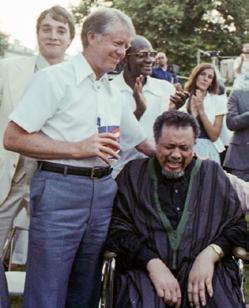
In the first “Dan’s Den” after I became Editor of Jersey Jazz, Dan lamented the fact that he would have to skip the 2019 Satchmo Summerfest because “my docs decided that New Orleans in August is not recommended for old guys.” However, he was there “in spirit” because Mosaic Records’ Michael Cuscuna and Scott Wenzel (more about them on page 15) organized a tribute to Dan, which, he said, “focused on the 70th birthday of DownBeat, which I put together as the then Editor ... the proudest achievement of my long career in serving jazz ... I sent it to Louis who responded via special delivery, opening with ‘I received the magazine, and it knocked me flat on my ass!’ The sweetest words I ever heard!”
I can’t top that, but after hearing of Dan’s death, I pulled Jazz people off of my bookshelf and began rereading the wonderful words of this wonderful man.
Founded in 1972, The New Jersey Jazz Society has diligently maintained its mission to promote and preserve America’s great art form—jazz. To accomplish our mission, we produce a monthly magazine, Jersey Jazz ; sponsor live jazz events; and provide scholarships to New Jersey college students studying jazz. Through our outreach program Generations of Jazz, we provide interactive programs focused on the history of jazz. The Society is run by a board of directors who meet monthly to conduct Society business. NJJS membership is comprised of jazz devotees from all parts of the state, the country and the world.
You become an integral part of the NJJS community, and the history and future of jazz
Access to 11 Digital Issues of our Award Winning Jersey Jazz Magazine
— Featuring Articles, Interviews, Reviews, Events and More
Discounts to our Jersey Jazz LIVE! Sunday Concerts
Discounts at NJJS Sponsored Concerts & Events.
FREE Listing on NJJS.org “Musicians List” with Individual Website Link
FREE Gig Advertising in our Monthly eBlast
THE RECORD BIN
Visit www.njjs.org or email info@njjs.org for more information on our programs and services
A collection of CDs & LPs available at reduced prices at most NJJS concerts and events and through mail order www.njjs.org/Store
JOIN NJJS
Family/Individual $45
(Family includes to 2 Adults and 2 children under 18 years of age)
Family/Individual 3-Year $115
Musician Member $45 / 3-Year $90 (one time only, renewal at standard basic membership level.)
Youth $15 - For people under 21 years of age. Date of Birth Required.
Give-A-Gift $25 - Members in good standing may purchase unlimited gift memberships. Applies to New Memberships only.
Fan $75 - $99
Jazzer $100 - $249
Sideman $250 - $499
Bandleader $500+
Corporate Membership $1000
Members at Bandleader level and above and Corporate Memberships receive special benefits. Please contact Membership@njjs.org for details. The New Jersey Jazz Society is qualified as a tax exempt cultural organization under section 501(c)(3) of the Internal Revenue Code, Federal ID 23-7229339. Your contribution is tax-deductible to the full extent allowed by law. For more Information or to join, visit www.njjs.org
Magazine of the New Jersey Jazz Society
VOLUME 52 • ISSUE 09
Jersey Jazz (ISSN 07405928)
is published monthly for members of The New Jersey Jazz Society
382 Springfield Ave., Suite 217, Summit, NJ 07901 973-229-0543 • info@njjs.org
Membership fee is $45/year.
All material in Jersey Jazz, except where another copyright holder is explicitly acknowledged, is copyright ©New Jersey Jazz Society 2024. All rights reserved. Use of this material is strictly prohibited without the written consent of the NJJS.
EDITOR
Sanford Josephson, editor@njjs.org
ART DIRECTOR
Michael Bessire, art@njjs.org
CONTRIBUTING PHOTO EDITOR
Mitchell Seidel, photo@njjs.org
CONTRIBUTING EDITORS
Noal Cohen, Bill Crow, Joe Lang, Ricky Riccardi, Jay Sweet
CONTRIBUTING PHOTOGRAPHERS
Michael Bocande, Jack Bradley, John Posada, Mitchell Seidel
WEBMASTER
Christine Vaindirlis
WEBSITE DESIGN
Prism Digital
DIRECTOR OF ADVERTISING
Cydney Halpin, advertising@njjs.org
ADVERTISING RATES
Full Page: $135, Half Page: $90, 1/3 Page: $60, 1/4 Page: $30
For reservations, technical information and deadlines contact advertising@njjs.org or visit njjs.org/Magazine/Advertise . Make payment at PayPal.com: payment@ njjs.org, or via check made payable to NJJS, 382 Springfield Ave., Suite 217, Summit, NJ 07901
New Jersey Jazz Society, Officers 2024
PRESIDENT
Cydney Halpin, pres@njjs.org
EXECUTIVE VP vicepresident@njjs.org
TREASURER
Mike Katz, treasurer@njjs.org
VP, MEMBERSHIP membership@njjs.org
VP, PUBLICITY
Sanford Josephson, sanford.josephson@gmail.com
VP, MUSIC PROGRAMMING
Mitchell Seidel, music@njjs.org
RECORDING SECRETARY Irene Miller
CO-FOUNDER
Jack Stine
IMMEDIATE PAST PRESIDENT
Mike Katz
DIRECTORS
Jay Dougherty, Cynthia Feketie, Paul Flexner, Pete Grice, Carrie Jackson, Caryl Anne McBride, Robert McGee, James Pansulla, Stew Schiffer, Elliott Tyson, Jackie Wetcher
ADVISORS
Don Braden, Mariel Bildsten, Ted Chubb, Al Kuehn, Jason Olaine
The New Jersey Jazz Society’s 2024 Scholarship Winners— pianist Lasse Corson, saxophonist Joseph Foglia, saxophonist Isaac Yi, and trumpeter Gabriel Chalick—will perform at the November 3rd Jersey Jazz LIVE! concert in Madison, NJ. They will be joined by four veteran professionals—guitarist/music director David O’Rourke, bassist Mary Ann McSweeney, drummer Alvester Garnett, and tenor saxophonist/flutist Don Braden.
Two of the scholarship winners are seniors at William Paterson University—Corson and Foglia. Corson, from Minneapolis, is the winner of the $1,000 award for Jazz Performance; Foglia, from Raleigh, NC, is the recipient of the $1,000 scholar-
ship for Jazz Composition. Yi and Chalick graduated this year from Princeton University. Yi, from Leonia, NJ, won the $500 scholarship for Jazz Performance, and Chalick, from Naples, FL, was the recipient of the $500 award for Jazz Composition.
This summer, Corson attended the Betty Carter Jazz Ahead Residency at the Kennedy Center. He began playing classical piano, but “the room for imagination and collaboration drew me in (to jazz) and away from the classical music I was studying before. Dr. David Demsey, William Paterson Coordinator of Jazz Studies, described Corsen as “a tremendous, imaginative player who can react and excel in many musical situations.”
Foglia attended the Jazz Aspen
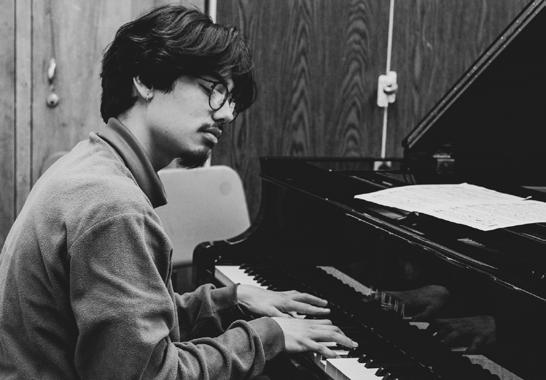
Snowmass in Aspen, CO, playing in the Afro-Caribbean Big Band led by trumpeter Etienne Charles. This month, he’s performing with Charles’ Creole Soul band at the Keystone Korner in Baltimore and Missy Lanes in Durham, NC. He’s also playing with his band at the Liberty Harbor Festival in Jersey City. Foglia is a repeat scholarship winner. In 2023, he won the $500 award for Jazz Performance.
Dr. Demsey said Foglia is, “an imaginative and very advanced composer/
arranger for someone of his young age.” Yi, who was originally attracted to jazz after hearing Charlie Parker’s “Yardbird Suite”, is working on recreating the music of the 1995 Verve album, Charlie Parker with Strings. Rudresh Mahanthappa, Associate Director of Princeton’s Program in Musical Performance, said Yi is “one of the best student musicians I have encountered in my career as a jazz educator.”
Chalick is pursuing his Master’s Degree in Jazz Performance at Mont-
clair State’s John J. Cali School of Music. He performed with the Montclair State University Jazz Ensemble at the recent Montclair Jazz Festival. According to Mahanthappa, Chalick is “an incredibly thoughtful and sensitive trumpet player and composer.”
Influenced by Pat Martino, with whom he studied, David O’Rourke has performed with such jazz legends as pianists Tommy Flanagan and Cedar Walton, alto saxophonist Jackie McLean, and trombonist Curtis Fuller. Mary Ann McSweeney has played with jazz luminaries such as Dizzy Gillespie and Bucky Pizzarelli and served for several years on the faculty of Lincoln Center’s Middle School Jazz Academy. Alvester Garnett, who recently performed at the Central Jersey Jazz Festival in Somerville, NJ, is an Adjunct Professor in the Jazz Studies program at Montclair State’s John J. Cali School of Music. Braden, an NJJS Advisor, has played with such

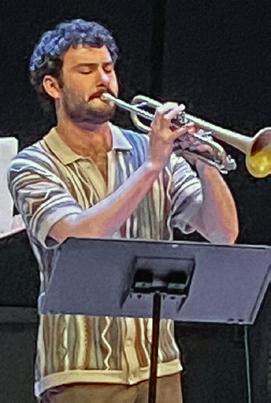

jazz greats as Betty Carter, Freddie Hubbard, and Wynton Marsalis. He is also Director of the Litchfield Jazz Camp and spent 15 years as Director of the New Jersey Performing Arts Center’s Jazz For Teens program. Prior to the concert, the music professionals will participate in a roundtable discussion with the scholarship leaders.
The NJJS Scholarship Competition was open to all New Jersey college students currently enrolled
in an undergraduate music program, as well as to New Jersey residents currently enrolled in an out of state undergraduate program.
: The Madison Community Arts Center is located at 10 Kings Road in Madison, NJ. The Jersey Jazz LIVE! concerts begin at 3 p.m. Admission will be $10 for NJJS members and $15 for non-members. Student admission is $5 with valid ID. There will be light re-
freshments for purchase. To order tickets in advance, log onto artsintrinsic. ticketleap.com/jersey-jazz-live-nov/
: Funding for Jersey Jazz Live! has been made possible, in part, by funds from Morris Arts through the New Jersey State Council on the Arts/Department of State, a partner agency of The National Endowment for the Arts. This program is also proudly supported by a grant from The Summit Foundation.
Special Guests are Guitarist David O’Rourke, Trumpeter Joe Mosello, and Vocalist Paula Johns
BY RICKY RICCARDI

If the audience for the Jazz on a Sunday Afternoon series in Toms River has proven one thing it’s that big bands are here to stay. About 80 years after the heyday of the Swing Era, nothing packs them in at the Grunin Center like a big band, swinging like mad. It’s a timeless sound that will never die, and it will be featured at the Grunin Center on October 13 when the Jazz Lobsters return to perform at 3 p.m. For well over a decade, the Jazz Lobsters Big Band has been regularly featured at Ocean County College and has set--and broken--the attendance record for the jazz series multiple times. Featuring the cream of the crop in the Tri-State area, the Jazz Lobsters will be featuring some special guests in October, including guitarist David O’Rourke and trumpeter Joe Mosello. The Dublin-born O’Rourke has been a constant presence on the New York and New Jersey scene since
the early 1980s, getting the chance to perform with many giants over the years, including Bucky Pizzarelli, George Benson, Brother Jack McDuff, Benny Powell, Etta Jones, Cedar Walton, and many more. Trumpeter Mosello toured with Maynard Ferguson’s band for five years and was part of Ferguson’s famed recording of “Gonna Fly Now” from Rocky. He’s played lead trumpet with every big band in New York from Toshiko Akiyoshi and Louis Bellson to Bob Mintzer and the Thad Jones-Mel Lewis Orchestra and has accompanied such vocalists as Frank Sinatra, Ray Charles, B. B. King, Sammy Davis Jr., and Sarah Vaughan.
Vocals will be handled by the critically-acclaimed Paula Johns of Philadelphia, who has been successful with her popular tributes to Ella Fitzgerald and Dionne Warwick. This will be Johns’ first appearance at the Grunin Center, and
it promises to be a memorable one.
Special guests notwithstanding, the group’s legion of fans know that they’re in for a good time any time the Jazz Lobsters show up. Previous shows have featured everything from Swing Era anthems of Benny Goodman and Count Basie to hot Latin and Salsa arrangements; fans of roaring big band music will not be disappointed.
: The New Jersey Jazz Society is a proud supporter of the Jazz on a Sunday Afternoon series, which is made possible through funding from the Wintrode Family Foundation and the Ocean County College Foundation.
The Jazz Lobsters concert begins at 3 p.m. on Sunday, October 13. The Jay and Linda Grunin Center for the Arts is located on College Drive on the campus of Ocean County College. For information and tickets, log onto grunincenter.org or call (732) 255-0500.

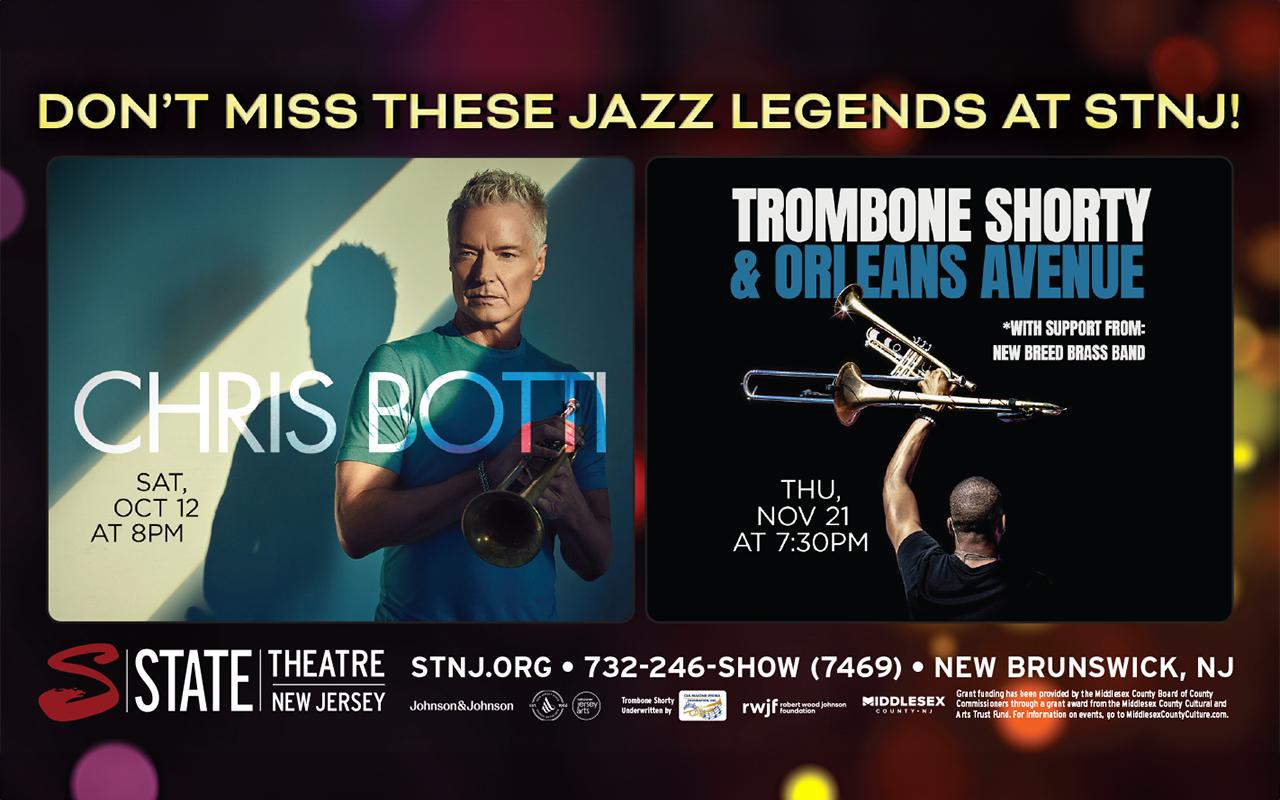

“A Way with Words That Made Me Hear and Feel Things in the Music That Were Positively Intoxicating”
BY SANFORD JOSEPHSON
In 1938 when Dan Morgenstern was eight years old, he and his mother fled Nazi-controlled Austria for Copenhagen. Nine years later, they arrived in New York, and Morgenstern was not interested in seeing the Statute of Liberty or the Empire State Building. He just wanted to go to 52nd Street.
Morgenstern, jazz writer, historian, jazz advocate and fan (and Jersey Jazz columnist), passed away in New York on September 7, 2024, at the age of
94. Everyone has a Dan Morgenstern story, and many of them will be related here, in addition to the numerous details about his glorious life and career.
Upon reaching New York, Morgenstern and his mother were reunited with his father, who had escaped to France before getting to the United States. With his father’s help, 17-yearold Dan was hired as a trainee in the Time-Life mailroom and subsequently worked as a New York Times copy boy before being drafted into the Army.
After returning to civilian life, he attended Brandeis University and discovered the Boston jazz scene, eventually meeting George Wein, who owned the Storyville Jazz Club and was about to launch the Newport Jazz Festival.
Wein helped Morgenstern and his college friends hire Stan Getz to perform a concert on the Brandeis campus, and Morgenstern wrote about it for The Justice, the student newspaper. It was his first published jazz article. After graduating from Brandeis, he covered the Randall’s Island Jazz Festival in 1959 for The New York Post and continued not only writing about jazz musicians but establishing personal friendships with them as well.
In an interview with the Smithsonian, Morgenstern told about a groundbreaking moment with tenor saxophonist Coleman Hawkins. “Coleman did a very big thing for me in terms of establishing me in the musicians’ circle,” he said. “Cole-
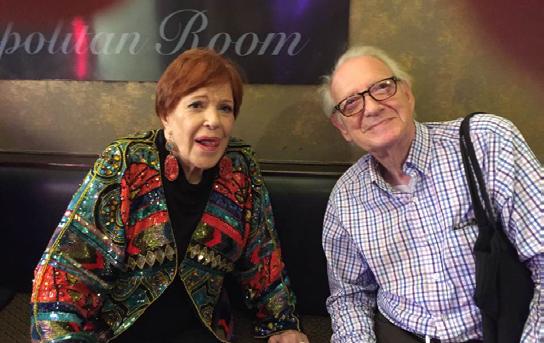
man was known for never buying anybody a drink. It’s not that he was cheap. He once explained it to me— he said, ‘You buy somebody a drink. Then they buy you one. You wind up drinking more than you really want.’
“Coleman had this big, booming voice,” Morgenstern continued. “Even in a noisy bar you could hear him over the crowd; his voice really carried. One night he called out to me in the Copper Rail, one of the midtown musician watering holes: ‘Danny! What are you drinking?’ Everybody turned around and looked. That was like my invitation.”
Morgenstern went on to edit Metronome and DownBeat magazines; he reviewed jazz for The Chicago SunTimes; won eight Grammy Awards for his liner notes; was named a National Endowment for the Arts Jazz Master in 2007; and received three Deems Taylor Awards for excellence in music writing from the American Society of Composers, Authors, and Publishers.
Two of the awards were for his books, Jazz people (Harry N. Abrams: 1976) and Living With Jazz (Pantheon: 2004). From 1976-2011, he served as Director of the Institute of Jazz Stud-
ies at Rutgers University-Newark, building that organization into one of the largest sources of jazz information and recordings in the world.
The foreword of Jazz people was written by Dizzy Gillespie, who complained about how Charlie Parker was treated while he was alive. “He was treated like a misfit by the society,” Gillespie wrote. “As for some of the books about him, especially the so-called biography, they are fairy tales. Dan Morgenstern, I’m happy to say, doesn’t write fairy tales.”
In his last “Dan’s Den” column for Jersey Jazz, Morgenstern remembered Michael Cuscuna, the Founder of Mosaic Records who passed away in April. Thanking Cuscuna “for all you’ve done for the music,” Morgenstern mentioned that Cuscuna had found a new partner at Mosaic, Scott Wenzel, “who knows jazz from all aspects, including the perspective of a musician.”
After hearing of Morgenstern’s
death, Wenzel said, “I’m sure we each have our moments when we first heard the name, Dan Morgenstern. For me, it was 1971, and I was given a birthday gift of the RCA Victor/Vintage Series LP called Swing, Vol.1. The notes were by Dan, and they gave me a clearer picture of the importance and brilliance of the music, which was new to this 11-year-old. Little did I know that I would spend many hours at the Institute of Jazz Studies some 20 years later to do research for Mosa-
ic and become a friend of this beautiful man, Dan The Man. He used to see me walk in and say, ‘Aaahh, the man from Mosaic’ in his inimitable voice.”
Morgenstern was a living history book for those too young to have seen and heard many of the jazz giants of the past. On Facebook, David Ostwald, Leader of the Louis Armstrong Eternity Band, described this unique role.
“With beautiful writing and riveting first-hand reports, Dan brought to life people I revered but never met and

history that shaped the present but had always felt hopelessly distant. He brought me to Louis Armstrong’s side at the Roxy Theater when he first met Louis, to inside the studio where Louis made his only recording with Duke Ellington, to Brandeis University in 1948 where he produced an Art Tatum concert and where he heard and met Billie Holiday for the first of many times. He made me be there when James Baldwin, upon hearing Louis Armstrong play the national anthem at the 1957 Newport Jazz Festival, told him, ‘That’s the first time I liked that song.’”
Ricky Riccardi, Director of Research Collections at the Louis Armstrong House and author of two books about Armstrong (a third is on the way), wrote a lengthy Facebook tribute to Morgenstern, describing him as someone who “had a way with words that made me hear and feel things in the music that were positively intoxicating. Dan reminded me
about the human beings making this music and made me always root for them ... Maybe the saddest thing for me right now,” Riccardi continued, “is that I was in the middle of going over the proofs for my next book when I got the word. I can only make very minor changes at this point, but the first acknowledgement in the back of the book was for Dan; now I must change the present tense verbs to past.” Riccardi added, however, that, “Like the musicians he loved and championed, Dan Morgenstern is immortal.”
Vincent Pelote, Senior Archivist Digital Preservation Strategist at the Institute of Jazz Studies, worked with Morgenstern from 1978 until Morgenstern’s retirement in 201l. “I was in awe of him,” Pelote told me, “because as a record collector I read numerous album notes penned by him and purchased many albums based solely on his informative and insightful notes. Dan had an encyclopedic knowledge
of jazz. He, at some point, was the last of the jazz historians who knew and hung out with some of the legendary figures like Louis Armstrong, Hot Lips Page, Roy Eldridge, Coleman Hawkins, and so many others. He gave us insight into the personalities of figures that most of us only knew through books, magazine articles, and sound recordings. He elevated the art of writing album notes to a level that few have been able to match.”
Pianist Emmet Cohen was thrilled when Morgenstern agreed to write the album notes to Volumes 1 and 2 of
“
Cohen’s Master Legacy Series. In Vol-
ume 1, which featured Cohen playing with drummer Jimmy Cobb, Morgenstern wrote about the joy of finding “a young dynamo musician who is so committed to connecting the music’s present with its rich past, and who understands that past so very well ...”
Volume 2, featuring a collaboration with legendary bassist Ron Carter also included another young musician, drummer Evan Sherman. Morgenstern gave him a shout out: “talented drummer Evan Sherman,” he wrote, “new to me but not to Ron Carter.”

Loren Schoenberg, tenor saxophonist and Senior Scholar at the National Jazz Museum in Harlem, pointed out, on Facebook, that, “it’s not just musicians who have influenced the ecology of jazz during its century of ascendancy. Although neither a grandstander nor a bandstander, Dan Morgenstern deserves a special place in the history and continuing evolution of this great American art form ... Through his voluminous writing, pioneering leadership of the Institute of Jazz Studies at Rutgers University, and stewardship of major jazz pub-
lications, Dan always remained far above the partisan battles ... He championed the cause of so many artists, paying no heed to the fads of the day.”
Pianist/vocalist Daryl Sherman called Morgenstern a “one-ofa-kind true gentleman. He could hear multi levels of tonal effects in recordings or live music and translate with just the right word to enhance a listener’s experience.
“Also, Dan loved songs—all kinds. His IJS colleague and dear friend, Vincent Pelote, pointed out that, ‘Dan fancied himself a bit of a
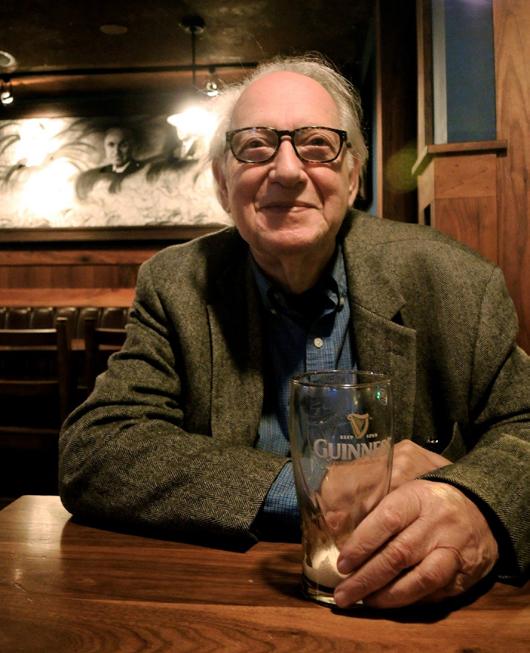
crooner.’ Vince got to accompany him on guitar. But it was at the annual New Orleans Satchmo Summerfests that launched him as a crooner. Producer Marci Schram didn’t have to nudge hard to get Dan to get up and sing with David Ostwald’s band.
Later, it became a tradition in New York at Ostwald’s steady Birdland gig. Dan would sing on his October birthday (See “Dan Morgenstern’s 94th Birthday Bash”, page 19). Being a pianist, singer, and good friend, I got the title, ‘first call pianist and vocal coach.’ We rehearsed only on the phone. It was a challenge, especially trying to find his key. However, Dan knew just what he wanted to sing and how—mostly Louis-related, but sometimes he’d throw in a charmer like ‘Never Swat a Fly’ or (“I’ll Be Glad When You’re Dead) You Rascal You.’ It really knocked us all out.”
At the end of Jazz people, Morgenstern brilliantly put jazz into perspective. “Every jazz musician,” he
wrote, “has a special story to tell, for jazz is above all a music of individual expression within a collective framework. It is also, despite the advances made in recent years, an art and craft that demands much, too much, from its practitioners. Its circumstances are physically and spiritually taxing, and while it is often hailed as an art, it is still treated as a commodity.
“Yet, jazz prevails. It continues to cut across boundaries of race, class, culture, and language. It has been one of the lights in the tunnel of the twentieth century. Born in slavery, it has become the universal song of freedom, a celebration of the resilience and power of the human spirit. In our time, especially, that is no small achievement.”
Morgenstern is survived by his wife, Elsa, and two sons, Adam Oran (named for the trumpeter Oran “Hot Lips” Page) and Joshua Louis (named for Louis Armstrong).
OCTOBER 24,
Master, eight-time Grammy winner, longtime Director of the Institute of Jazz Studies, and Jersey Jazz columnist
Reprinted from NJJS.org, October 2023
— celebrated his 94 th birthday. The very next night, Dan was feted in person at Birdland, where David Ostwald’s Louis Armstrong Eternity Band has held sway for 23 years. Ostwald has overseen annual birthday celebrations for Morgenstern for more than a decade, and the 2023 edition was another night to remember. The event was completely sold out in advance, and the audience included jazz luminaries such as saxophonist/bandleader/ scholar Loren Schoenberg, vocalist Catherine Russell, blogger/videographer Michael Steinman, and Vincent Pelote, Senior Archivist and Digital Preservation Strategist at the Institute of Jazz Studies at Rutgers-Newark.
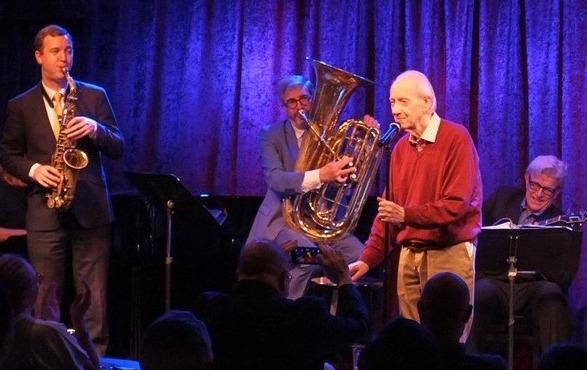
In addition to the leader’s tuba playing, Ostwald’s band for the occasion included Bria Skonberg on trumpet and vocals, Jim Fryer on trombone and vocals, Will Anderson on reeds, Arnt Arntzen on banjo, guitar, and vocals, Vince Giordano on bass, and Alex Raderman on drums.
Ostwald mostly chose repertoire from the eight albums Morgenstern won Grammys for in the “Best Album Notes” category, including “Honeysuckle Rose,” “Azalea”, “I’ve
Got a Heart Full of Rhythm”, “When Your Lover Has Gone”, “Basin Street Blues”, and more. Russell joined in on an especially memorable “I Can’t Give You Anything But Love.”
But the highlight was when the 94-year-old Morgenstern took to the stage to sing “I Can’t Believe That You’re in Love With Me,” backed by his vocal coach, pianist Daryl Sherman. Morgenstern sang with great charm, staying in tune and displaying a good sense of time. The audience showered him with applause. — RICKY RICCARDI
FEATURING NJJS 2024 Scholarship Winners with Industry Professionals
DAVID O’ROURKE, Music Director/Guitar
DON BRADEN, Sax
MARY ANN MCSWEENEY, Bass
ALVESTER GARNETT, Drums

SUNDAY, NOVEMBER 3 3:00 PM
STREET PARKING ON KINGS ROAD
$ 10 MEMBERS | $ 15 NON-MEMBERS
$ 5 STUDENTS (WITH VALID I.D.)


“My Music Should Always Have Meaningful Melodic Content, Something You Come Away Humming”
If Benny Golson never touched the tenor saxophone he would be remembered as a composer. Golson, who died September 21, 2024, in New York at the age of 95, wrote some of the most memorable jazz standards, including “Whisper Not”, “I Remember Clifford”, “Along Came Betty”, and “Killer Joe”.
“Every stroke of his pen became another classic,” trumpeter Eddie Henderson told WRTI Radio’s Shaun Brady, the day after Golson’s death. In
a 2007 interview, Golson explained his composing philosophy to Brady.
“I had a love affair with melodies,” he said. “As far as I’m concerned, my music should always, now and then, have meaningful melodic content, something you come away humming.”
Growing up in Philadelphia, Golson started taking piano lessons when he was nine years old. As a teenager, he saw Lionel Hampton’s band with tenor saxophonist Arnett Cobb at Philadelphia’s Earle The-
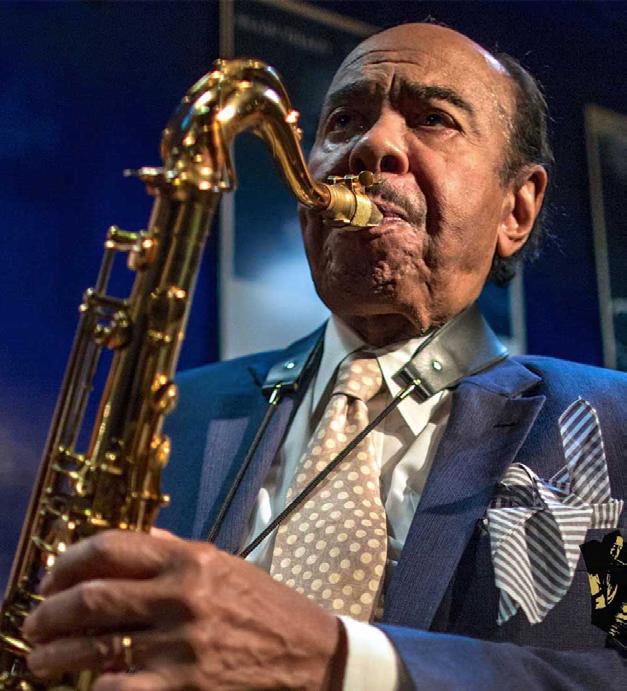
ater. “That day changed my life,” he told the Star-Ledger in 2004. “I told Arnett that years later, and he had tears in his eyes. I guess it was the sound of the horn, the bright lights glittering on this piece of gold plumbing, the reaction of the audience going wild. I just got caught up in that.”
At Philadelphia’s Benjamin Franklin High School, Golson’s classmates included a large group of future jazz greats including John Coltrane, pianists Ray Bryant and Red Garland, tenor saxophonist Jimmy Heath and his brother, bassist Percy Heath.
Golson began writing and ar-
ranging music while a student at Howard University, which only offered instruction in classical music. He would leave campus at night to play in local jazz clubs. Arguments with conservative music teachers prevented him from getting a degree, although he was later awarded an honorary doctorate by the university.
In 1958, he joined Art Blakey’s Jazz Messengers, staying only a year but making his mark with his writing. The 1958 groundbreaking Blakey Blue Note album Moanin’ contained four of his compositions: “Along Came Betty”, “Blues March”, “Are You Real”,

and “Drum Thunder Suite”. Writing about the album for AllMusic, Michael G. Nastos said, “’Along Came Betty’ and ‘Blues March’ will always
“
have a home in the repertoire of every student or professional jazz band.”
After being with Blakey, Golson joined trumpeter Art Farmer to form the Jazztet, a sextet that also featured McCoy Tyner on piano and Curtis Fuller on trombone. Writing about the group’s 1960 debut Argo album, Meet the Jazztet, Stephen Cook of AllMusic called the band “One of the top hard bop contingents of the ‘50s and ‘60s. The Art Farmer and
Benny Golson co-led group known as the Jazztet featured some of the best original charts and soloing of the entire era. While the group was only in existence between 19591962, its excellent reputation could rest on this stunning disc alone.”
In the ‘70s, Golson moved to Los Angeles, at the urging of Quincy Jones, and wrote music for TV shows such as Mannix, Mission Impossible, and M.A.S.H.
As an educator, he had residencies at several universities including William Paterson, the Berklee College of Music, and Rutgers. In 1996 he was named a National Endowment for the Arts Jazz Master “for his distinctive compositions and arrangements and innovative tenor saxophone playing, notable additions to the jazz canon, his work in film and television studios, and his contributions to jazz education.”
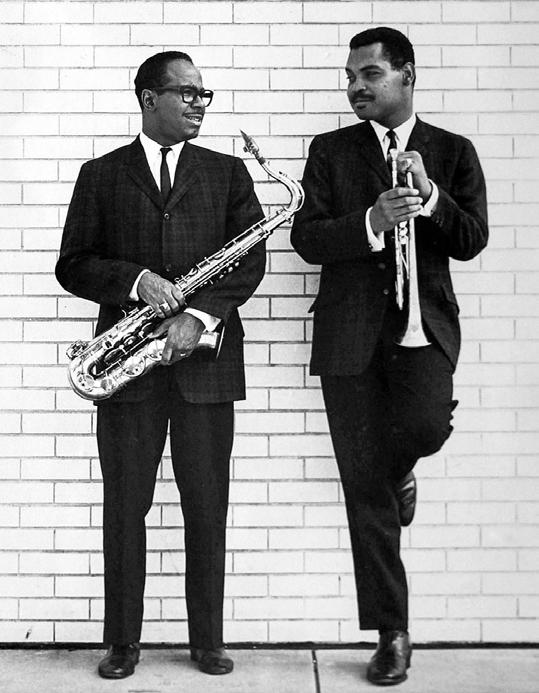
Other awards included a 1994 Guggenheim Fellowship and a 2007 Mellon Living Legend Legacy Award.
In 1987, he was part of a U.S. State Department tour of Southeast Asia, New Zealand, Indonesia, Malaysia, Burma, and Singapore. In honor of Art Blakey, he created the “Jazz Messengers—A Legacy to Art Blakey” tour of the U.S., Europe, and Japan from 1998 to 2000. Trumpeter Terell Stafford, Director of Jazz Studies at Temple University’s Boyer School of Music, described Golson to WRTI’s Brady as “an incredible icon in this music. But I still think he’s underrated in so many ways. I always tell my students, ‘If you really want to know the tenor saxophone, start by transcribing Benny Golson.’ So much music and so much harmony come out of his horn, and his songs sound so beautiful while being so complex.”
On Facebook, keyboardist Mike LeDonne recalled that, “No one was ever more enthusiastic and excited by the musicians in their band than Benny Golson. His joy at hearing the band was palpable and genuine, and yet he was never pleased with his own playing. He was very critical of himself even though he’d be playing some incredible things, fresh new things that I never heard anyone play before or since. His tunes came from his heart and soul but were always a little different than anyone else’s. He had a melodic and harmonic genius that I think is right up there with all the real greats like Ellington, Silver, Shorter etc ... Like his playing, his compositions and arrangements had that unmistakable Benny Golson sound.”
Golson is survived by his wife, Bobbie; a daughter, Brielle; and three sons—Odis, Reggie, and Robert—from an earlier marriage —SJ
Big Band in the Sky continued on page 51
‘The Only Jazz Musician
Who Inspired a Whole Movie’
IN 2018, BENNY GOLSON RECEIVED THE JAZZ Journalists Association’s Lifetime Achievement Award. Introducing him at the awards ceremony, jazz writer Patricia Willard, who received the JJA Lifetime Achievement Award in Jazz Journalism, said: “He’s the only major jazz musician who inspired a whole movie, Steven Spielberg’s The Terminal.”
Golson was one of 57 jazz musicians who were part of the famous photograph called “Great Day in Harlem.” Taken by Art Kane, it appeared in Esquire Magazine in 1958. In The Terminal, Tom Hanks’ character, Victor Navorski, was stranded at JFK Airport after a military coup in his native country, the fictional Krakozhia. While marooned at the airport, Navorski tells someone that his father, a jazz fan, attempted to get autographs of all the musicians in the Esquire photo but died before getting the last one, who was Benny Golson. Golson made a brief appearance in the film so
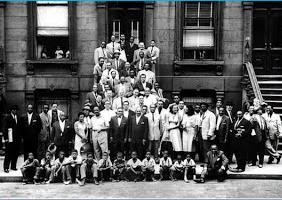
Navorski could get the autograph. In a 2004 interview with the Los Angeles Times’ Don Heckman, Golson said that, at first, he “really didn’t get why he was selected for the movie among all the musicians from the photo who were then still alive. “I think I found the answer,” he added, “when both Steven and Tom, independently, told me how much they liked my song, ‘I Remember Clifford’. And when they said they liked it the best of all my tunes, I realized that they were familiar with my body of work as well.”
The only remaining living jazz musician from that photo is 94-year-old Sonny Rollins.

Bromberg’s
Broad
Musical Range Makes Him Difficult to Categorize, Which May be a Reason Why He Isn’t More Widely Recognized
BY JAY SWEET
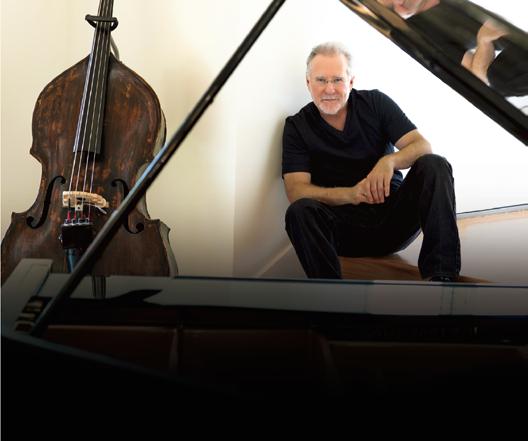
Brian Bromberg is a virtuosic bassist, renowned for his technical prowess and inventiveness on double and electric bass. His latest B Squared album, LaFaro, pays tribute to the legendary bassist Scott LaFaro, who also showcased extraordinary skill and creativity on the double bass. Bromberg will pay homage to LaFaro at the Gateway Playhouse in Somers Point, NJ, as part of the South Jersey Jazz Society’s Jazz@ the Point Festival, on October 11. He will also be at New York City’s Mezzrow on October 12. Pianist Tom Zink and drummer Charles Ruggiero will be joining Bromberg on both gigs
“ Scott,” Bromberg said, “was an amazing bassist with the Bill Evans Trio, and, tragically, he died in a car accident at just 25, coming home from a gig. I wasn’t even a year old when he passed, but it’s mind-blowing to consider what he achieved on the bass in such a short time, espe-
cially during an era without modern bass amplification or pickups.
“I love the record,” Bromberg continued, “because we recorded it like a real jazz album—over two days in the studio. What audiences can expect from both the performance and the album is three musicians who get along great and play well together, all to honor Scott LaFaro.
“Having been taken so young, it’s impossible not to wonder, if Scott LaFaro was that inventive and creative at 25, what would he have been doing at 45? Who knows where he would have gone musically? Thinking about it is truly heartbreaking.
“One of the most rewarding aspects of this project for me has been getting to know Scott’s sister, Helen. She contributed some of the liner notes for the album and shared a really beautiful sentiment that moved me to tears when I read it. Her stories about Scott, their family, and
their lives resonated deeply with me. If you listen to Scott’s playing and mine, you’ll hear that I don’t sound anything like him, but you can certainly hear his influence in my music.”
Bromberg was originally reluctant to make the album, but “I went back and listened to Scott’s recordings, and that’s when I realized how much he had impacted my playing. I heard his fearless soloing, his concept, and all the incredible things he did with the bass—how he flew around the instrument while playing in Bill Evans’ trio, rarely hitting the downbeat, and yet creating all these magical moments. That wasn’t necessarily my style, but his soloing and lyricism had a profound effect on me. So, I finally agreed to do the recording because I felt a real connection to it. It was pretty amazing.”
There’s also a personal connection for Bromberg. His first big gig was with Stan Getz, and LaFaro’s last
gig was with Getz. “I should also mention my connection to Bill Evans and bassist Marc Johnson, who was in Evans’ trio,” he said. “I met both Bill and Marc when I was 18, in Tucson. We became friends, and Marc arranged for me to play an entire set with Bill Evans at the Village Vanguard. But I was young, insecure, and too scared, so I passed on the opportunity. It’s the biggest musical regret of my life. After Bill passed, I realized how that one set, even playing just one song with him, would have changed my life. Bill was so kind, and I desperately wanted to play with him, but I completely freaked out. That experience taught me an important lesson: when a door opens, you have to walk through it.”
Bromberg began his musical journey as a drummer before switching to bass. His passion for music became evident early on, and his path was unique compared to many traditionally schooled musicians from larger cities.
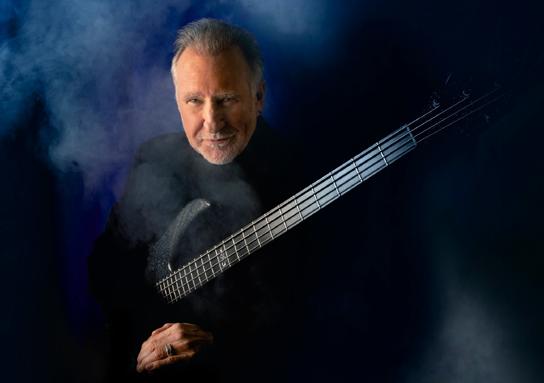
“I’m from Tucson, a small town,” he said, “but big enough to have everything a major city has—just on a smaller scale. There was a downtown, and there were gigs. At the time, there was a handful of musicians in Tucson, and some of them were quite good. I also practiced day and night. When I was in school, there was a nonprofit organization that brought jazz bands to Tucson to do concerts, workshops, clinics, and lessons for an entire week. I got to watch and meet legends like Dexter
Gordon, Ron Carter, Buster Williams, Rufus Reid, Kenny Barron, Ben Riley, and others. I ditched school all of the time to listen to those guys. That’s how I met Bill Evans and Marc Johnson.
“I dropped out of high school and started working four nights a week as a young teen. I was dedicated. I played everything, from the symphony to marching bands, the rodeo, parades, country gigs, rock gigs, and jazz gigs. It was an incredible education. There wasn’t really anyone to study with pri-
vately, so my teacher was the mirror. I’d practice in front of it, watching my hands, making sure I looked relaxed and that my fingers were in the right place. I wanted to make sure the math, musically speaking, made sense.”
Whenever someone came to town or to Phoenix, which is more than 100 miles away, Bromberg would go to hear them play. “I’d drive to Phoenix for a $25 gig just to play jazz. My whole life was music. Growing up kind of isolated in Tucson forced me to create my own world. If I had grown up in New York City, there would have been 500 bass players better than me at the time. But in Tucson, there were only a handful of musicians who could play, so we were all working every night. It was fantastic.”
At the recommendation of Marc Johnson, Bromberg’s first big break came when he started working with Getz. “After meeting Marc Johnson when he visited Tucson, we devel-

oped a friendship. We played a lot. I was 18 at the time. Seven months later, he recommended me to Stan Getz. At the time, the band included Andy LaVerne on piano, Chuck Loeb on guitar, and Victor Jones on drums.”
Bromberg is equally impressive on both upright and electric bass, but he credits Getz for pushing him toward the electric. “Before I played electric,” he explained, “I was really anti-electric bass and anti-electric
music because I played a lot of classical music and was really into traditional jazz, so it was all upright. I looked at the electric bass as just a piece of wood made in a factory that had no vibe at all. But Stan asked me, ‘Do you play electric bass?’ and I said, ‘Yes.’ The next day, I went out and got an electric bass and had to learn to play it quickly, somewhat reluctantly.
“Then I heard Jaco Pastorius play ‘Portrait of Tracy,’ and it just blew my mind. Even more than all the fast stuff he did, it was so creative and unique. Back in those days, everyone doubled. Why wouldn’t you? It allowed you to play a lot more music in all different styles and have a lot more fun. Both the upright and electric bass are wonderful instruments, very creative, but completely different—even though they’re related.”
Bromberg admitted that, while the experience with Getz was musically rewarding it was also person-
ally challenging. “I eventually quit Stan’s band because of Stan. I just couldn’t take him anymore as a person,” Bromberg recalled. “Rufus Reid was a huge mentor of mine, and I remember calling him from my hotel for advice since he had worked with Stan. I told him everything that was going on, and he told me, ‘You gotta follow your heart. You gotta do what’s right. You gotta do what you feel is best for you.’ As hard as it was, what was right for me was to quit the band. There were times when Stan was amazing—when he wasn’t drunk or stoned, he was great. But the minute he altered his consciousness, he became a different person. He was not a happy man. Let’s put it that way. But he was literally flawless musically.”
After working with Getz, Bromberg’s reputation as a top-tier bassist skyrocketed, and he became a first-call musician, collaborating with a wide array of legends. Some
of the notable names included Dave Grusin, Freddie Hubbard, Anita O’Day, Toots Thielemans, and Arturo Sandoval. However, where Bromberg has truly left his mark is through his extensive catalog as a leader, which began in 1986. His albums as a leader showcase his virtuosity and versatility, spanning contemporary jazz, traditional jazz, and tribute records to masters such as Pastorius, Jimi Hendrix, and Antonio Carlos Jobim. He also explored unaccompanied bass solos. Bromberg’s broad musical range makes him difficult to categorize, which may be both his greatest strength and a reason why he isn’t more widely recognized by casual fans. His ability to cross genres so effortlessly can sometimes confuse listeners who prefer musicians with a more singular sound or style.
“It’s really hard to balance my career,” Bromberg reflected. “I truly enjoy contemporary jazz. I enjoy
traditional jazz. I just like music, so I don’t care about the label. If a song is slamming, or if a song is beautiful or feels good, I want to play on it. What do I care what the format or the label is? If I write it or if I’m playing on it, my heart’s in it. I do the best I can with what I have. So it drives me crazy when people judge me because I cross genres. The bottom line is it’s music. I don’t do the same thing over and over again, and I prefer that. I ask people not to judge me but to appreciate the music for what it is, not what it is not.”
: The Jazz@the Point Festival runs for three days, from October 10-12, at various venues in Somers Point, NJ. For more information, log onto southjerseyjazz.org or call (609) 289-0326. To hear the full interview check out The Jazz Real Book Podcast https://open.spotify. com/show/0nS4HH56YVpefoQiaESjqQ?si=0005d77ed7624444
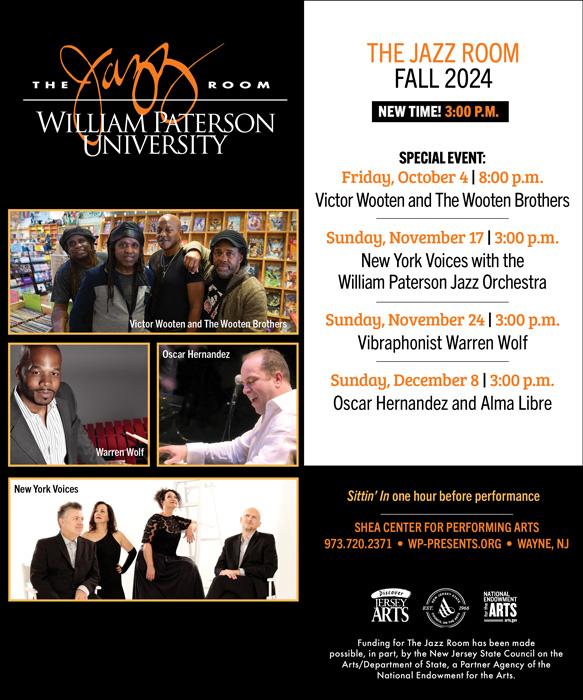

and Stephen Sondheim for West Side Story, with several Scofield originals.
Reviewing it for AllAboutJazz, Neil Duggan wrote: “This selection of covers and originals features an entertaining mix of rock, country, and swing, which liberates the trio’s improvisational dynamism. Scofield sounds as distinctive and inventive as ever.”
Expect to Hear the Grateful Dead’s ‘Uncle John’s Band’, Dylan’s ‘Tambourine Man’, and Neil Young’s ‘Old Man’
BY SANFORD JOSEPHSON
n October 2023, guitarist John Scofield released an album on the ECM label called Uncle John’s Band. The two-CD recording mixed the Grateful Dead title track, Bob Dylan’s “Tambourine Man”, Neil Young’s “Old Man”, the Miles Davis/Bud Powell jazz standard “Budo”, and “Somewhere”, written by Leonard Bernstein
When the John Scofield Trio appears at The Newton (NJ) Theatre on October 17, the concert, Scofield said, will include “a lot of stuff from Uncle John’s Band. When you look at the composers on the CD—one is Bob Dylan, another is Miles Davis, and another is Leonard Bernstein. How could they play all those kinds of music? But all of them sort of meet in the center ground.” Those songs are on the album, the 72-year-old Scofield added, because “I like the songs. That’s why we played them with our arrangements. It’s not like we’re playing those tunes. We’re using
those tunes to play our own music.”
And, he said, it works really well with his trio. “I love the way Vicente plays (bassist Vicente Archer). He’s a real open player who can really walk and swing. He straddles a bunch of stuff. We can play some funk stuff with him but, to me, it sounds absolutely at home. And, Bill Stewart is one of the great jazz drummers I’ve ever played with. He’s spoiled me over the years. He’s so good at making the music move.” In November, the trio will be spending six nights—during Thanksgiving week—at New York’s Blue Note. Archer started off as a guitarist but switched to acoustic bass as a student at Northeastern University in Boston. While still in college, he performed with alto saxophonist Donald Harrison and pianist Eric Reed. He has also played or recorded with trumpeter Nicholas Payton, saxophonist Kenny Garrett, and vocalist Norah Jones, among
many others. Stewart studied under drummers Eliot Zigmund and Horacee Arnold at William Paterson University. In a review of his 2018 self-produced album, Band Menu (with tenor saxophonist Walter Smith III and bassist Larry Grenadier), DownBeat’s Ken Micallef called Stewart, “one of the greatest drummers on the planet.”
Scofield’s website describes him as someone “who goes from traditional jazz to funk-oriented music.” That range, he explained, just reflects “the times I’ve grown up in.” In the mid-’70s, Scofield played with drummer Billy Cobham. “This was fusion funk and very technical,” he said. “I just went where the good jobs were—first with Billy’s band with the Brecker Brothers
and then the George Duke/Billy Cobham Band for two years.” Before that, though, he had the opportunity to play in a more mainstream jazz setting with Gerry Mulligan.
I interviewed Scofield in 2014 when I was working on my book, Jeru’s Journey: The Life and Music of Gerry Mulligan (Hal Leonard Books: 2015). “I had attended Berklee,” he told me,” but

The Hudson quartet, from left: Larry Grenadier, Jack DeJohnette, John Scofield, and John Medeski
I dropped out and was just working around town, trying to get into the jazz scene. Gerry came to town to play at the Jazz Workshop for a week, and he wanted to add vibes and guitar to his quartet. So, he called Alan Dawson, the drummer, and Alan recommended me and Dave Samuels (on vibes). We played a week with Gerry’s group with Bill Goodwin on drums, Jack Six on bass, and Tom Fay on piano. It was great. We got to hang with Gerry and meet him. I couldn’t believe I was playing with a jazz legend.”
Shortly after that, Mulligan was scheduled for a reunion concert with Chet Baker at Carnegie Hall, and he reached out to Scofield and Samuels to join the rhythm section of pianist Bob James, bassist Ron Carter, and drummer Harvey Mason. That, Scofield recalled, “was unbelievable. We didn’t know he was going to call back for anything. We were unknown. When I go back and listen, I realize
what an amateur I was. It was just great to be there.” The concert was recorded and released on a two-disc album by CTI in November 1974.
In the early ‘80s, Scofield spent three years with Miles Davis’ band during Davis’ fusion years. He appeared on three Davis Columbia albums: You’re Under Arrest, The Decoy, and Star People, plus Siesta, a Warner Bros/WEA album, that was the soundtrack for a movie of the same name starring Ellen Barkin, Gabriel Byrne, and Jodie Foster.
“I feel lucky to have known him and to have been mentored by him,” Scofield said. “It’s the same thing with Gerry Mulligan and Jim Hall, Bob Brookmeyer, and Joe Henderson. My direct mentors were (vibraphonist) Gary Burton and (bassist) Steve Swallow. These guys just tell you the stories about their early years. With Miles, it was amazing because he was talking about being a kid
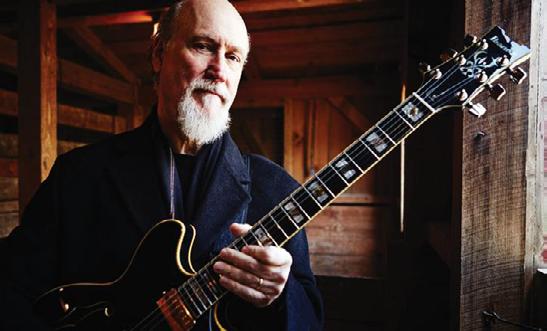
with Bird and playing with him.”
Scofield met Hall in the early ‘70s. “We hung out. He lived in the Village. I lived in the Village, and we played some. I also knew Pat Martino. He would tell me about his early years, coming to Harlem and playing with Lloyd Price’s band and Willis Gator Jackson and then the fusion guys. I got to know John McLaughlin and Larry Coryell, and both were very kind to me.
As for current guitarists, Scofield declined to provide a list of his favorites because “I would forget somebody.” But, he did mention
a few. “I love Peter Bernstein, Pat Metheny, and Bill Frisell. Pat went to Berklee when I was a student. Gary Burton brought him up from Miami. I was 20; he was 19 or 18, and we became friends. Bill Frisell and I played together a bunch in the ‘80s.”
Scofield has recorded more than 30 albums as a leader. One that’s considered a classic is the 2017 Motema Music recording, Hudson, with keyboardist John Medeski, bassist Larry Grenadier, and drummer Jack DeJohnette. The album, as with Uncle John’s Band, is
split between pop/rock tunes and original compositions. The former are mostly associated with Woodstock. Among the selections are Bob Dylan’s “Lay Lady Lay” and “A Hard Rain’s A-Gonna Fall”, Joni Mitchell’s “Woodstock”, and Robbie Robertson’s “Up on Cripple Creek”. In a DownBeat review, Paul Barros pointed out that, “Though everyone contributes equally, Scofield is key, because his succinct, lyrical guitar melodies really sing. Try chiming in on ‘Lay Lady Lay’, which DeJohnette invests with a reggae feel, or ‘Up On Cripple Creek’, to experience just how nuanced Sco’s delivery is. He’s even more thrilling when he leaps outside the chords on ‘A Hard Rain’s A-Gonna Fall’.”
That quartet, Scofield said, “was an amazing group. Jack DeJohnette was one of the giants of the drums. Jack doesn’t want to tour anymore, but I got the tail end of his touring years. Jack and me and (keyboardist)
Larry Golding made a record for ECM and toured 15 years ago.”
Before finishing the interview, Scofield recalled that he once again had the chance to play with Gerry Mulligan in 1995, at the end of Mulligan’s career. It was on one of Mulligan’s last albums, the Telarc Jazz recording, Dragonfly. “I was so lucky to get to play with Gerry again,” he said. “He was sick at the time, but he didn’t seem sick to me. He played beautifully. He was one of the great arrangers. Being on that record was wonderful. I didn’t realize he was going to be gone right after that.” All 10 tracks on the album were Mulligan originals. He passed away on January 20, 1996, at the age of 68.
: The John Scofield Trio concert is at 8 p.m. on Thursday, October 17, at The Newton Theatre, located at 234 Spring St. in Newton, NJ. For information and tickets, log onto skypac.org or call (973) 940-NEWT.

SUNDAYJAZZ


Sunday October 13 • 3:00pm
Gibbs and Clarinetist Buddy De Franco Co-Led Quintets
BY NOAL COHEN
In the late 1940s, Terry Gibbs, along with Milt Jackson and Teddy Charles, built upon the legacies of swing era icons Lionel Hampton and Red Norvo and established the gold standard for modern jazz vibraphonists. Now approaching his centennial birthday, Gibbs has amassed an enviable body of work that spans decades. He has worked with many of the most important musicians of his time (most of whom he has outlived) and has led ensembles large and small. Talented,
versatile, and always on the lookout for new opportunities, Gibbs survived and thrived despite the economic and social challenges often encountered by those dedicated to a career as a jazz musician. His music was clearly beholden to the bebop innovators
Charlie Parker and Dizzy Gillespie but always infused with an ebullient, accessible, hard swinging pulse.
Gibbs was born Julius Herbert Gubenko, on October 13, 1924, into a Jewish family that had emigrat-
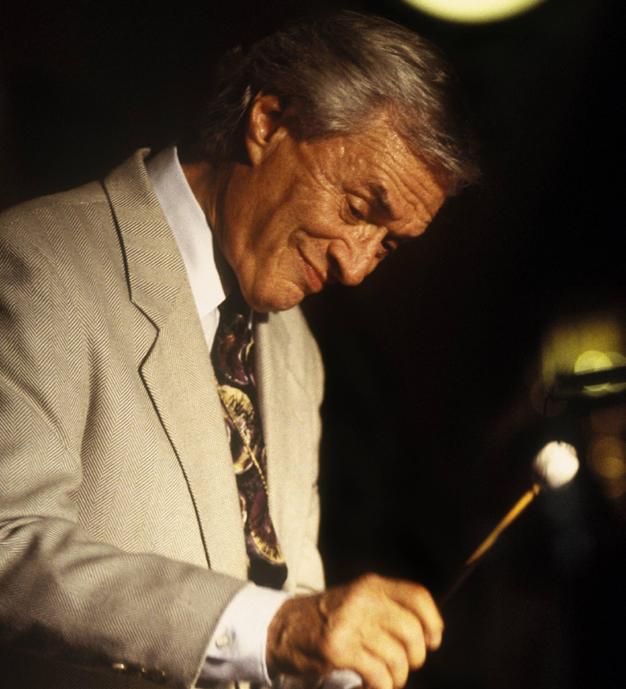
ed from Russia and was residing in Brooklyn. His father was a violinist and leader of an ensemble called Abe Gubenko and His Radio Novelty Orchestra. His brother Sol was a drummer who, along with Abe, provided much of Julius’ early musical training. His first instrument was xylophone.
At the time, the neighborhood of East New York had many Jewish residents and, not surprisingly, an abundance of friends sharing an interest in music, including Leonard Garment, a saxophonist who would become famous as an advisor to President Richard Nixon, and Norman “Tiny” Kahn, a talented and influential drummer, composer, and arranger who died tragically at the age of only 29. (In 2010, Gibbs led a big band tribute to Kahn at the Los Angeles Jazz Institute Festival.)
Terry, as he would be called for most of his life (taking the name from the boxer Terry Young), was a
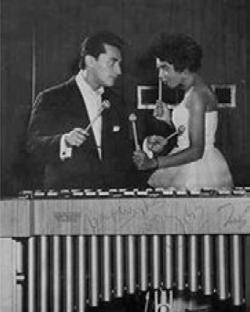
child prodigy who appeared on Major Bowes Amateur Hour at the age of 12. He attended Samuel J. Tilden High School in Flatbush but never graduated. By the age of 16, he was playing drums and mallet instruments professionally, cutting his teeth in the resorts of the Catskill Mountains and meeting like-minded young musicians such as guitarist Chuck Wayne and saxophonist Frankie Socolow.
Drafted into the Army in March 1943, Gibbs was stationed at Fort Dix and then assigned to the 8th Armored Division in Louisiana but was able to
switch to the Army Band. While on furlough, he heard Dizzy Gillespie and Charlie Parker on 52nd Street and knew immediately that their music, bebop, would become his as well.
After three years in the Army, he returned to New York having decided the vibraphone was his instrument of choice; and he began to make his presence known. His first gig was with vocalist/poet Babs Gonzales (aka Lee Brown) and his first recording (1946) was with a quintet led by clarinetist Aaron Sachs for the
Manor label. The drummer on the session was Tiny Kahn. Recordings with tenor saxophonist Allen Eager and bassist Chubby Jackson led to a stint with Buddy Rich’s big band.
In 1948, thanks to a recommendation from Jackson, Gibbs joined Woody Herman’s Second Herd, one of the most talented and innovative ensembles in modern jazz, but also one plagued by the ravages of drug use. Gibbs, though, never succumbed to this temptation. At various times, the band includ-
“ OPENING NIGHT
WE TORE BIRDLAND UP. CHARLIE PARKER WAS THERE. ”
ed saxophonists Stan Getz, Zoot Sims, Al Cohn, Gene Ammons, and Serge Chaloff; trumpeters Shorty Rogers and Ernie Royal; trombonists Bill Harris and Earl Swope; pianist Lou Levy; bassists Oscar Pettiford and Chubby Jackson; and drummers Don Lamond and Shelly Manne. Recording with Herman for Capitol Records, Gibbs soloed on several tracks that attracted great attention, most notably “Early Autumn”, “Lemon Drop”, “Keeper of the Flame”, and “More Moon.”
After a brief and unfulfilling stint with Tommy Dorsey, Gibbs got a call to do a television show with clarinetist and bandleader Benny Goodman which led to two years (1950-1952) with the “New Benny Goodman Sextet.” In his biography, Good Vibes: A Life in Jazz (with Cary Ginell, Scarecrow Press, 2003), the vibraphonist describes, sometimes comically, the trials and tribulations of working with
the notoriously difficult Goodman. But recordings by the ensemble for Columbia Records and other appearances led to new employment opportunities as well as recognition in DownBeat and Metronome magazine polls.
In 1953, Gibbs decided to venture out on his own, using a quartet format. While performing in Detroit, he heard a young, African-American woman playing piano, clearly influenced by Bud Powell, with an approach that he found both astounding and appealing. He convinced her (with the approval of her family) to go on the road and for the next four years they toured and recorded prolifically. Her name was Terry Pollard (1931-2009) and, as a bonus, she was a proficient vibraphone player. Superficially, the Gibbs-Pollard partnership seemed an unlikely one for the time – a Jewish man from Brooklyn and an African-American woman from Detroit, seven years his junior;
and there were the usual racial problems involving accommodations and acceptance when touring certain parts of the country. But their act was generally well received, especially the vibraphone duet “battles.” In his book, Gibbs
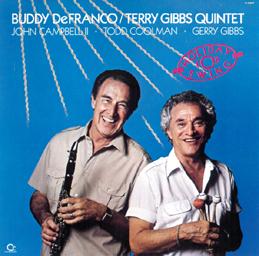
The 1988 Contemporary Records album, Holiday Swing. Scott Janow of AllMusic wrote, “The two virtuosos, clarinetist Buddy DeFranco and vibraphonist Terry Gibbs, always inspire each other ... they make for a perfectly compatible team.”
described their opening at Birdland: “Opening night, we tore Birdland up. Charlie Parker was there. He heard us play and offered Terry a job. In fact, he came in every night and kept offering her a job. She turned him down and, to make a long story short, she stayed in my band for four years. That was one of the winningest groups I ever had and it became a highlight of my life.”
The collaboration of the two Terrys generated a number of excellent recordings for the Brunswick, EmArcy, and Mercury record labels as well as performances throughout the USA and Canada. In my opinion, the finest is Gibbs’ first LP for the EmArcy label, simply titled Terry Gibbs, a hard swinging affair from start to finish. The album received four stars in DownBeat (March 21, 1956), the reviewer commenting: “Terry’s first LP for EmArcy is one of his happiest,
even unto the audible staccato outbursts of pleasure from him and his cohorts. Chief among these cohorts is the nonstop swinging pianist, Terry Pollard, who could have had a lot more solo space to my taste. Also contributing to the wailing air of the session is the strong bass of Herman Wright and the steadily pulsating drums of Nils-Bertil Dahlander (aka Bert Dale), the Swedish drummer who has absorbed and utilized well the considerable experience he has gained here.”
By 1958, Gibbs had purchased a home in Woodland Hills, CA, and began working in the NBC studios, but he continued to tour with a quartet including pianist Claude Williamson, bassist Gary Peacock, and drummer Gary Frommer, an ensemble that I heard in person in my hometown of Rochester, NY.
Gibbs assembled a Los Angeles-based big band in 1959 that came to be known as “The Dream Band.”

With a like-minded and consistent personnel of outstanding soloists including trumpeter Conte Candoli; trombonist Frank Rosolino; saxophonists Med Flory, Joe Maini, and Richie Kamuca; and drummer Mel Lewis, the ensemble performed at LA clubs such as the Sundown, Seville, and Summit. At these venues, intrepid engineer Wally Heider made many high quality, live recordings that were issued on the Contemporary
and Verve labels. Arrangements were provided by Flory, Al Cohn, Marty Paich, Bill Holman, Bob Brookmeyer, and Manny Albam; and the book contained many updates of big band classics. With its main goal of giving the band members opportunities to play good music at a time when big bands were not in vogue, the ensemble lasted until 1962. Interest in the “Dream Band” continues today as a GoFundMe effort is currently on-
going to issue for Gibbs’ centennial, newly discovered recordings of the band (1959: Vol. 7, The Lost Tapes).
But small groups were the vibraphonist’s most comfortable setting. Alice McLeod (1937-2007), like Terry Pollard, was a very talented pianist from Detroit whom Gibbs heard and hired for his quartet. In 1963, the quartet recorded four albums including Jewish Melodies in Jazz Time (Mercury Records) and El Nutto (Limelight Records). It was during this period that Gibbs introduced McLeod to saxophonist John Coltrane who hired and later married her. Gibbs lost his pianist, but jazz benefited in the long run as the groundbreaking and spiritual approach of Alice and John Coltrane pointed the music in a new direction.
The versatile Gibbs had a notable career as Musical Director for several television shows in the 1960s and 1970s such as Operation Entertain-
ment (ABC, 1968) and those starring Regis Philbin and the multi-talented Steve Allen. Allen, himself an accomplished pianist and songwriter, had a long and productive relationship with Gibbs resulting in several recordings including Steve Allen Presents Terry Gibbs at the Piano (Signature Records) and Rhythm and Blues (Dot Records).
Gibbs’ last major collaboration was with another veteran of the 1940s bebop revolution, clarinetist Buddy De Franco (1923-2014). Between 1981 and 2003, the two giants co-led quintets that toured the world and recorded several hard-swinging albums for the Palo Alto, Chiaroscuro and Contemporary labels. One of these, Chicago Fire (Contemporary Records), from 1987, features the debut of Gibbs’ son, Gerry (born in 1964), a fine drummer and percussionist, now a leader and sideman in his own right. In 2020 and 2021, at the height of the Covid-19 pandemic, Gerry over-
came many obstacles to produce a tribute album to Terry called Songs from My Father (Whaling City Sound Records). It features many jazz legends performing Terry’s compositions and contains the last recordings of the great pianist Chick Corea.
Gibbs is one of very few musicians still with us whose career began in the 1940s. His eight- decade-long career produced more than 50 jazz albums as a leader and nearly 150 original compositions. He was inducted into the Percussion Arts Society Hall of Fame in 2000 and as recently as 2022, could still be found in the recording studio (The Terry Gibbs Songbook, Whaling City Sound Records).
Happy birthday, Terry, and thank you for all the wonderful music you have given us for so long!
: Noal Cohen is an author, musician, jazz researcher, and discographer based in Montclair, NJ.


Sat, Oct 19 at 7:30PM
Experience an extraordinary evening of musical innovation with two trailblazing artists pushing the boundaries of contemporary jazz music.
The Hot Sardines
Fri, Nov 8 at 7:30PM
The Hot Sardines are bringing their infectious energy to McCarter, promising an evening of timeless jazz music, with a fresh twist that only they can deliver.
Fri, Jan 30 at 7:30PM
Join the legendary Sun Ra Arkestra for an evening of cosmic jazz and Afro-futurism.
(Formerly Christian Scott)
Thu, Feb 13 at 7:30PM
The 5x Grammy Nominee Chief Xian aTunde Adjuah, is a revolutionary force in jazz, renowned for his dynamic live performances and genre-defying blend of styles and cultures.
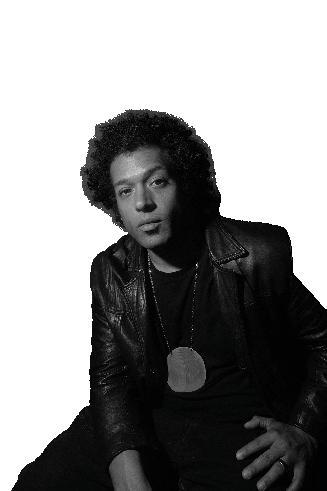
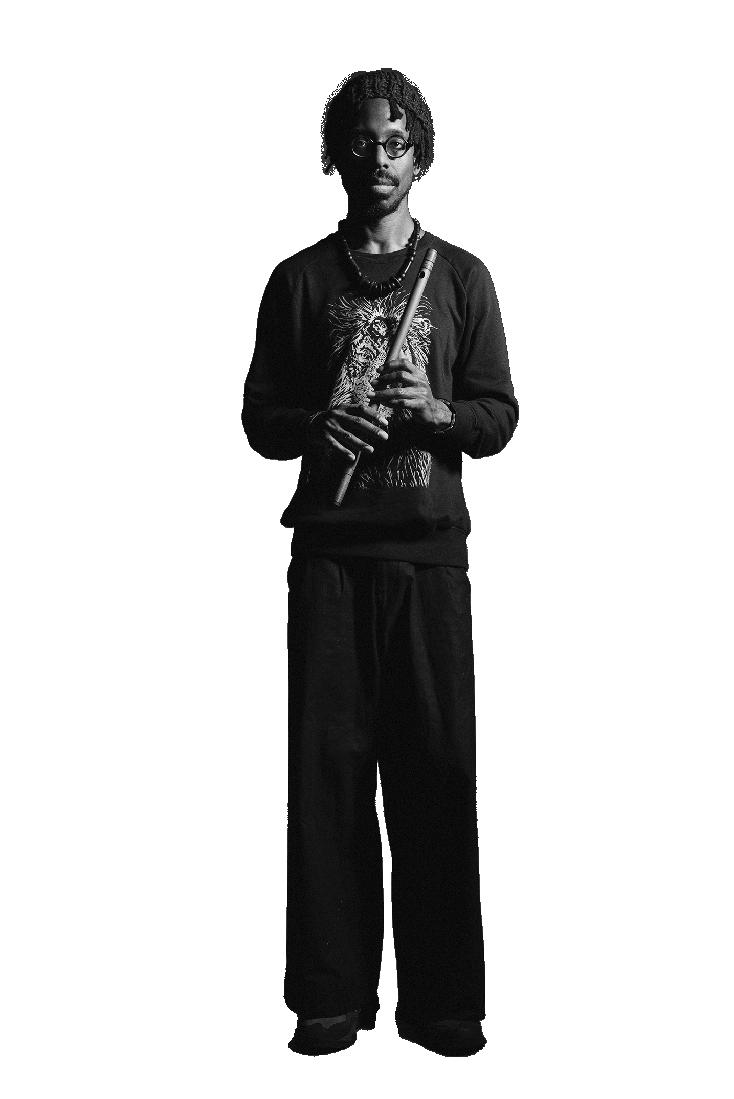
Buy your tickets today!

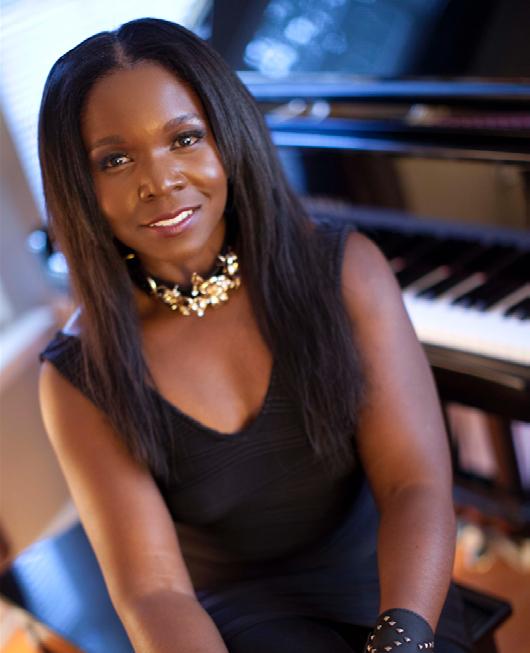
“I’m a Jazz Musician, But I Love Playing Music ... All Styles of Music”
BY SANFORD JOSEPHSON
From 2018 to 2020, pianist Shamie Royston was Director of the New Jersey Youth Symphony Jazz Orchestra’s Big Band and also taught as a guest artist. Now, Royston is rejoining NJYS as Director of NJYS Jazz and the Jazz Orchestra, succeeding trombonist Dion Tucker. Royston began her new duties in July and is “very excited to be in this position, to work with the students. We had our first session in early September, a massive sight-reading session.”
When Royston led the Big Band four years ago, the NJYS Jazz Direc-
tor was Julius Tolentino, whose Newark Academy Jazz Band won Jazz at Lincoln Center’s Essentially Ellington competition earlier this year. Royston’s passion for jazz education, Tolentino told me, “is infectious. I’m so happy to see her leading the NJYS Jazz program now. We have also worked side by side as part of the Carnegie Hall education program and at the Jazz Education Network. There’s no denying her energy and excitement when working with students of all ages. She is a force to be reckoned with, just like with her piano playing!”
One of Royston’s initiatives will be to “bring in a few guest artists to play with the ensemble for our main concert (December 15 at the Union County Performing Arts Center in Rahway, NJ) and for workshops. I may also try to do some more outside performances with some of our top groups.”
Her main purpose is to show her students “the love of music. I’m a jazz musician, but I love playing music. I want them to understand the basic concepts of what jazz is, the roots of jazz, learning how to be experimental,
free, and improv when they’re playing—not just when they’re playing jazz but for all styles of music. When I teach, I bring in different styles all the time. I started on classical piano. I like to know the music that the kids listen to today, and I kind of just tie all that in when they are playing—the whole aspect of music.”
Born in Denver, Royston and her sister Tia (alto saxophonist Tia Fuller) were introduced to jazz at a young age by their parents, who were public school teachers. As a teenager,
”

Performing with last year’s NJYS Jazz Orchestra: Palles Vasquez, Plainfield Academy for the Arts and Advanced Studies, left; and Luka Milnkovic, Summit High School.
Royston attended the Telluride Jazz Camp and then studied jazz at the University of Denver where she was mentored by trumpeter Ron Miles.
Her 2018 Sunnyside Records album, Beautiful Liar, received very favorable reviews. Jazz Weekly’s George W. Harris wrote of Royston’s “wondrous piano,” calling the album a “strong and soulful collection of originals plus one.”
National Public Radio’s Kevin Whitehead interviewed Royston
on the NPR program, Fresh Air, describing her as “a trained composer who knows how to manipulate her materials all sorts of ways.” Her music, he added, is “so appealing. It sounds like fun to play.”
Royston said she’s been influenced by many great artists, but one pianist who was very special to her was the late Geri Allen. “She was a huge mentor before I actually met her,” she said. “I used to listen to her all the time. I listened to all the
greats, but when I first heard her when I was younger, I said, ‘Who is this woman? I need to do it like that.’”
Currently, Royston is writing and composing for a new album, which will be released sometime next spring or fall. “I also just did an arrangement for Allison Miller, a great drummer. It’s a big band arrangement for her, and that should be coming out very soon.”
The New Jersey Youth Symphony Jazz Orchestra is a program of Berkeley Heights, NJ-based Wharton Arts, which has three other core programs: the Performing Arts School, Paterson Music Project, and New Jersey Youth Chorus. Its programs include private lessons and group classes, high-level ensembles and educational experiences, and performance opportunities for students of all levels, ages, and socio-economic backgrounds.
There are currently about 50 students in the jazz program, ages
12-17, from nearly 20 New Jersey communities. Other faculty members include baritone saxophonist Dave Schumacher, who is Director of Jazz Workshops, and bassist Gregory Williams, Director of the Jazz Big Band.
Helen Cha-Pyo, Wharton Arts
Artistic Director and Principal Conductor said, “We are absolutely thrilled to welcome Shamie Royston to the NJYS family as our new Director of Jazz. Shamie is an extraordinary artist and pianist as well as a dynamic jazz educator who has inspired countless young musicians with her talent and mentorship. Her passion, creativity, and vision will infuse our jazz program with fresh energy, and I couldn’t be more excited for our students to learn from her.”
: The December 15th jazz concert will be held at 5 p.m. on UCPAC’ s Hamilton Stage in Rahway. Tickets are available at NJYS.org.


When bassist Laura-Simone Martin was auditioning for the Monterey Jazz Festival’s Next Generation Women in Jazz Combo, she was asked this question: ‘What artist or artistic group inspired you the most and why?’ Following is what she wrote.
Shamie Royston is the artist that inspires me the most. As I learn from her every week in the New Jersey Youth Symphony Jazz Orchestra, I just get even more motivated to become excellent. When she tells her past stories of struggle from being a Black female instrumentalist in the jazz scene, it inspires me to thrive in the music world to help further push the Women in Jazz movement. My favorite story from her was when she was still coming up and at a jam session. The guys looked at her like she was a baby, cut her off when she was about to go on stage to play, etc. Because Shamie Royston is short, she was used to it, so

instead of going off at them with her words, she did it by her actions. So, she played into the role they were painting her as, but when she finally did go on stage to the piano and started playing, she blew them away and left them speechless.
Hearing empowering stories like that really makes me want to go far so that I can have that same effect on other young kids. I used to be insecure from this stigma of feeling like I was only in an ensemble (specifically in an orchestra) where I looked around the room, noticed I was the only Black person; and I felt like a diversity box checked off. And, it just really made me want to shed. Now it still is one of my main motivations ... So, just learning how to overcome that and how to lift up other people in the process from Shamie Royston is what makes her one of my inspirations.
: Simone Martin, a Jazz Studies student at Michigan State University, was a Jersey Jazz Rising Star in July/August 2022 and 2023. Both years she was one of 22 student musicians invited to join the Carnegie Hall NYO Jazz Orchestra.
“Part of NJCU’s Mission Statement is to Really be a Strong Resource, Specifically in the Hudson County Community”
New Jersey City University is rebuilding its Jazz Studies program and has named trumpeter Nathan Eklund, an NJCU Adjunct Professor since 2013, as Jazz Coordinator of the program.
“The University,” he said, “went through some kind of financial distress a few years ago and went through a bit of a reset. Now, it has found its financial stability with its financial footing. This is an opportunity to be part of the rebuilding of the jazz program. I’ve been connected to the program

in multiple ways for many years and see the opportunities that are there for students to come here and study.”
The number of current Jazz Studies students is small, but Eklund is hoping to build it back to its previous levels.
The 46-year-old Eklund grew up in Everett, WA, a suburb of Seattle and studied classical trumpet at Central Washington University in Ellensburg, WA. In 1998, he moved to the New York area to study jazz at William Paterson University. He earned his Master’s Degree at NJCU
in 2005, studying with trumpeters Scott Wendholt and Joe Magnarelli.
The NJCU program, Eklund said, “has been around forever. It was a teachers’ college for many years (changing its name from Jersey City State College in 1998). A ton of great musicians came through the program in the 1970s. There wasn’t actually a jazz degree program then, but there were lots of jazz ensembles. A lot of the musicians came through to get teaching degrees, but they were studying jazz while they were
here.” Until 1997, the jazz program was a Jazz Studies/Commercial Music track. Beginning in 1998, it was changed to Bachelor of Arts in Music - Performance: Jazz/Commercial.
“Part of NJCU’s mission statement,” Eklund said, “is to really be a strong resource, specifically in the Hudson County community, working and providing opportunities for the underserved communities. A big part of my focus initially is going to be reaching out and making contact with a lot of the schools in this area—North
Bergen, Union City, Bayonne, Kearny, and here in Jersey City; and also, in a lot of the surrounding communities such as Newark and Elizabeth. A lot of the schools have music programs and have students who would be great candidates for coming to college here.”
Also, he pointed out, “NJCU has the least expensive tuition of all the New Jersey state schools, and, on top of that, we’re actually offering
in-state tuition to all US and international students who attend right now. Current tuition for the full academic year is $14,459.76. The Honors Program at NJCU offers an annual scholarship of $9,000, plus the potential of additional state and federal grants. Along with the low tuition, all incoming freshmen are automatically considered for an academic scholarship. There are no separate scholar-
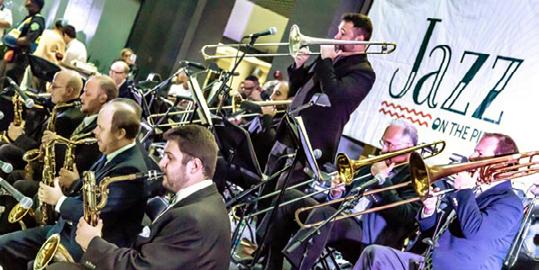
ship applications, and scholarships range from $2,000 to $8,000. We are the school that’s closest to New York City of any school that’s not in New York City. We’re in a great location, and all of our faculty are active performers in the New York City scene.”
Among the faculty members are pianists Garry Dial and Allen Farnham; drummers Winard Harper, Tim Horner, and Jeff “Tain” Watts; guitarist Mark Whitfield; trombonist Rob Edwards (an NJCU alum); and vocalist Sherrine Mostin.
On December 9, NJCU jazz students will present their end of semester jazz performance in the university’s Margaret Williams Theater, and the special guest will be saxophonist and NJCU alum Lakecia Benjamin. The NJCU students will be preceded by an opening set performed by the Elizabeth High School Jazz Ensemble. The concert, which starts at 7 p.m., is free and open to the public. At
the New Jersey Jazz Society’s December 2023 Jersey Jazz LIVE! concert in Madison, NJ, the Rising Stars opening act was a trio led by NJCU student trumpeter Parker Cheek, who will be graduating next spring. He was joined by NJCU student bassist Ahmod Bradley, and recent graduate, drummer Chris Paredes, an NJJS scholarship winner in 2019. This month, Eklund will be playing with the Roy Hargrove Big Band at the Jazz Gallery on October 3 and Dizzy’s Club on October 12. He’ll also be part of Lance Bryant’s big band on October 7, at Trinity Church in NYC during the day and at Newark’s Clements Place that night. “I’m trying to find that balance,” he said. “I don’t have any intent to give up my life as a performer.” And, he will continue his other teaching duties—Director of the Jazz House Kids Big Band and a member of the jazz faculty at Montclair State’s John J. Cali School of Music. SJ
BY BILL CROW
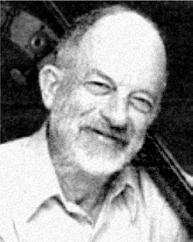
During the 10 years that I lived in Greenwich Village, in the 1950s, I discovered the city operated the Leroy Street public swimming pool, which I visited every Sunday morning during the summers when I wasn’t on the road. Weekday mornings at the pool were reserved for swimming lessons for the neighborhood kids, but Sunday mornings were for the adults. We called it our country club.
One Saturday I found Charlie Parker sitting on a bench in Washington Square Park. He was living in the East Village at the time. We sat and talked for awhile, and I mentioned the Leroy Street Pool to him. He said he would like to come, and sure enough,
Bill Crow is a freelance musician and writer. His books include Jazz Anecdotes, Jazz Anecdotes: Second Time Around, and From Birdland to Broadway. This column is reprinted with permission from Allegro , the monthly magazine of AFM Local 802.
the next day he showed up at the pool with swim trunks and a little rubber bathing cap. He enjoyed the pool that day, but I never saw him there again.
When we arrived at the pool that morning, we found that someone had climbed over the wall during the night and painted on the wall, in huge brown letters: MARVIN THE HAIRY
We laughed as we spread out our towels beside the water. Soon, two men dressed in khaki overalls came out of the dressing room and inspected the wall. They went back inside, and in awhile, one of them returned with a bucket of paint. The paint was nearly the same color as the wall, and the man carefully painted over all the letters. But he only painted the letters themselves, so, to our amusement, the graffiti was still legible in the fresh paint.
The other man returned, and they inspected it again. Realizing that the
message was still there, they got out the paint again and finally obliterated the letters. Charlie Parker and the rest of us got a good laugh from that, and afterward, whenever I met Charlie, we would mention Marvin the Hairy One, and laugh some more. · I played with Pee Wee Russell, both before and after he stopped drinking. During his later phase, we were having breakfast in a cafe in Boston one morning, and a couple walked in and recognized him. “Pee Wee!” cried the lady, and rushed over to him. He looked a bit nonplussed, and said hello. The lady turned to her husband and said, “He doesn’t remember us!” Then she said, “Pee Wee, you stayed at our house in St. Louis for three months!” Pee Wee nodded and mumbled, “If you say so.”
When I was once playing the Paul Whiteman radio show with Marian McPartland’s trio, Whiteman
was waving a baton at the studio orchestra for the benefit of the audience, but pianist Lou Stein was hiding beneath the rostrum wearing headphones, conducting the musicians with his forefinger.
Keith Bishop posted this on Facebook: “Bryant Byers told me a great anecdote about his dad, Billy Byers. When they lived in Paris, Billy used to regularly watch a musical segment that ended the broadcast day in France, and he saw and heard an amazing musician who played wine glasses, eliciting eerie and beautiful sounds by rubbing a moistened finger around the rims of crystal stemware. Billy was so taken with the musician that he made a note of the man’s name, and a few years later was scoring a horror film and decided he wanted that sound as a featured solo part with the orchestra. He contact-
ed the man’s agent and negotiated for him to play. The man arrived at the studio on the appointed day and time and asked Billy what style of music he was going to be playing, since he had to choose the proper wine with which to fill the glasses that made up his instrument. The proper variety and vintage chosen, he proceeded to fill every glass to the brim. His method of tuning the instrument consisted of consuming the amount of wine necessary to empty the glass enough to sound the required pitch. Unfortunately, by the time his instrument was tuned, he was too inebriated to play, and had to overdub his parts later!”
Gregory Waits reposted a friend’s post: “Interesting repartee at work last night.
Me: Playing solo piano and having a grand evening.
Intoxicated guest: I need
to use your microphone.
Me: (continuing to play)
I don’t have a microphone.
Guest: I only need it for a minute.
Me: I don’t have a microphone.
Guest: Well, I’ll just have a word with the manager then.
Me: Please do. Any requests?
Guest: I NEED to use your microphone
Me: (starting to play ‘You can’t always get what you want’) don’t have a microphone. (Guest leaves. Five minutes later, guest drops two ones in my tip jar) NOW can I use your microphone?’
Me: Sure.

Guest: (looking around piano) Well, where is it?
Me: In the trunk of my car.
Guest: (I’m being serious here) Why didn’t you tell me you didn’t have a microphone?
Me: (Takes break.)”

BY JOE LANG
Duke Ellington Copenhagen 1958 (Storyville – 8540) is a pure delight. The Ellington band in 1958 was in peak form with a blend of longtime stalwarts such as Johnny Hodges, Ray Nance, Harry Carney, and Cat Anderson and newer additions like Britt Woodman, John Sanders, Jimmy Woode, and Sam Woodyard. This album contains selections from the two concerts held at the KB Hallen Sports Center in Copenhagen on November 7, 1958. The original tapes were no longer available, but the broadcasts of the event were recorded, and this album is taken from this source, wonderfully remastered. The quality of the music, performance, and recording are first rate. It is a thrill to hear “Diminuendo and Crescendo in Blue” with a 27-chorus tenor solo by Paul Gonsalves, recalling his similar effort at the historic Newport 1956 concert. In addition to the 13 tracks from the concerts, there are three trio tracks finding Elling-
ton on piano with Don Byas on tenor sax and Jimmy Hamilton on clarinet from a 1950 jam, plus two solo tracks by Ellington from a 1950 social charity event. All of the bonus material was recorded in Copenhagen. This material is a must have for Ellington enthusiasts. storyvillerecords.com
Composer/arranger Mark Masters has been releasing a variety of albums over the years featuring his arrangements for ensembles of various sizes, the common feature of which are the scintillating arrangements by Masters. Sui Generis (Capri – 74172) is an album of Masters compositions he has arranged for an octet featuring trumpeter Tim Hagans. The balance of the players on the band are Nicole McCabe on alto sax, Jerry Pinter on tenor and soprano saxes, Dave Woodley on trombone, John Dickson on French horn, Jeff Colella on piano, Chris Colangelo on bass, and Kendell Kay on drums.
While Hagan’s horn is the focus of the album, each of the other players has an opportunity to display solo chops. Masters’ charts are well-conceived and always interesting for both players and listeners. caprirecords.com
Tenor saxophonist Jeff Rupert is a graduate of the jazz program at Rutgers University and is now the Director of Jazz Studies at the University of Central Florida and Host of “Jazz and the American Spirit” on Orlando’s WUCF-FM. During his musical journey from Rutgers to UCF, he played with such artists as Maynard Ferguson, Mel Tormé, Benny Carter, and Sam Rivers. Rupert still performs outside of his responsibilities at UCF, and It Gets Better (Rupe Media) is his latest album as a leader. He has all-star support from pianist Kenny Barron, bassist Peter Washington, and drummer Joe Farnsworth. The nine-song program includes Billy
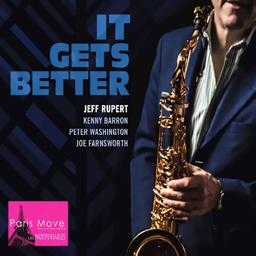
Strayhorn’s “Lana Turner (Charpoy),” Marc Shaiman’s “Nowhere to Go but Up”, and Burke and Van Heusen’s “Like Someone in Love,” plus six Rupert originals. Rupert is a swinging, straight-ahead player with a nice tone and a fine improvisatory mind. He also writes tunes that grab your ear. Combine his attributes with this majestic rhythm section, and the result is almost an hour of pleasurable listening. Available only as an MP3 download at amazon.com
One of the few true originals to arrive on the jazz scene was Charlie Parker. His influence can still be heard today
in the music of any player performing music based on post-Swing Era styles. Ornithology: The Best of Bird (Craft Recordings – 00753) contains 11 selections. The first six, “Ko-Ko,” “Now’s the Time,” “Cheryl,” “Parker’s Mood,” “Billie’s Bounce” and “Donna Lee” are studio recordings made between 1945 and 1947. “Confirmation” is from a 1947 Carnegie Hall concert; “Ornithology,” “Groovin’ High” and “Anthropology” are from 1947-48 gig at the Royal Roost; and “Salt Peanuts” is from the legendary 1953 Jazz at Massey Hall concert. This collection gives a fine overview of Parker’s genius and is a fine place to start for those looking to familiarize themselves with his artistry. For those familiar with his work and seeking a nice sampling of his music, this album is just right. (amazon.com
In addition to being a fine multi-instrumentalist, Colin Hancock is a jazz historian/archivist particularly taken
with the sounds of classic jazz as played by the territory bands of the Southwest.
Down Where the Bluebonnets Grow (Turtle Bay – 24004) is a 13-song collection played by The Joymakers, an octet including Hancock on cornet/ baritone and alto saxes/ trombone/vocals, David Jellema on clarinet/C-melody sax/cornet/vocals, Lauryn Gould on alto, tenor and soprano saxes/vocals, Dylan Blackburn on accordion, Weslen Borghesi on banjo, Shane Dickens on piano, Ryan Gould on bass, and Ryan Neubauer on drums. This spirited aggregation takes on a program of tunes that have stayed under the radar for the last six or seven decades, but the group furnishes them with a freshness and enthusiasm that will bring a smile to your face as your toes cannot stop tapping. turtlebayrecords.com
Since 1989, The Hot Club of San Francisco has been playing music inspired by the Quintet of the Hot Club
of France, the legendary band led by Django Reinhardt and Stephane Grappelli. Original Gadjo (Hot Club Records – 2706) is the HCSF’s 15th album, this one all originals by the members of the band. Gadjo is the Romani word for outsider, thus the title is reflective of the American roots of the players in the band. These outsiders have captured the spirit of the Gypsy jazz tradition with tunes that the original Hot Club group would have felt comfortable playing. Leader and band founder, Paul Mehling, has had a variety of bandmates during the 35 years of the band’s existence, but the constant has been the kind of robust sounds created on this album. hotclubsf.com
One of the master jazz vibraphonists on the current scene, Warren Wolf, has undertaken an interesting project of paying tribute to many of the vibraphone greats on History of the Vibraphone (Cellar Music – 120223).
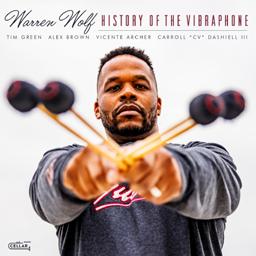
Those recognized include Terry Gibbs (“Bopstacle Course”), Lionel Hampton (“Midnight Sun”), Milt Jackson (“Django”), Bobby Hutcherson (“Herzog”), Gary Burton (“Captain Señor Mouse”), Roy Ayers (“Vibrations”), Dave Samuels (“Spring High”), Joe Locke (“Saturn’s Child”) and his own “I See You Baby, Looking at Me.” Wolf is joined by Tim Greene on alto and soprano saxes, Alex Brown on piano and Fender Rhodes, Vicente Archer
on bass, and Carroll “CV” Dashiell III on drums. Wolf has taken on the challenge of paying tribute to these masters while maintaining his own individuality and has succeeded magnificently. (See the Jazz History feature on Terry Gibbs, page 34.) cellarlive.com
Rebecca Kilgore spent several years performing in a duo setting with Dave Frishberg in Portland, OR, where they both resided. They also recorded three duo albums. Sadly, Frishberg succumbed to Alzheimer’s in 2021, and now Kilgore has been diagnosed with Lewy Body dementia. Fortunately, she was able to finish a final album before her difficulties ended her performing career. Fittingly, it is A Little Taste: A Tribute to Dave Frishberg (Cherry Pie Music – 201). She is joined in this endeavor by the trio of Randy Porter on piano, Tom Wakeling on bass, and Todd Streit on drums along with a variety of horn players, including long-
time musical cohort Dan Barrett on trombone for three tracks and her husband, Dick Titterington on trumpet or flugelhorn on six tracks. On five of the tracks, a string quartet is added. The tunes include nine songs with lyrics and/or music by Frishberg: “A Little Taste,” “Our Love Rolls On,” “Peel Me a Grape,” “Little Did I Dream,” “Heart’s Desire,” “Snowbound,” “Brenda Starr,” “You Are There” and “Eastwood Lane.” plus “Telephone Song” and “Ah, So Pure.” As you would expect, Kilgore absolutely nails each selection, nicely aided by Titterington’s fine charts. A bonus is the nicely written liner notes by Barrett. While it is hard to accept that we will be hearing no new recordings or performances by Becky Kilgore, this is a nice parting gift for her many fans. cherrypiemusic.com
Montreal-based songstress Caity Gyorgy is quickly becoming one of the premier jazz vocalists to arrive on the
scene in recent years. Hello! How Are You? (self-produced) finds her in the company of pianist Anthony D’Alessandro, bassist Thomas Hainbuch, and drummer Jacob Wutzke for a program of 11 tunes. Gyorgy has a voice that is instantly welcoming. Eight of the tracks are wonderful original songs by Gyorgy, who writes lyrics that are intelligent and flow nicely. To illustrate the inspiration for her songwriting, she includes a trio of songs from the Great American Songbook, “They Say It’s Spring,” “Baubles, Bangles & Beads”, and “It Never Entered My Mind.” It is always difficult to designate a singer as a jazz vocalist. It probably is safest to say that there is no strict definition, but you know one when you hear one; and Cait Gyorgy certainly is one, and a fine one at that. caitygurogy.com
The music of Cy Coleman has motivated many vocalists to devote albums to his songs. There is a new entry in
this category, and it is a winner. Vocalist Janis Siegel and pianist Yaron Gershovsky have teamed up to create
The Colors of My Life: A Cy Coleman Songbook (Club 44 – 4173). Culling the Coleman catalog to select 10 songs must have been a challenge, but Siegel and Gershovsky have done an admirable job of opting to include selections from a variety of sources, pop songs like “The Best Is Yet to Come,” “Witchcraft,” “That’s My Style,” “I’m Gonna Laugh You Right Out of My Life” and “Why Try to Change Me Now”; Broadway songs, “I’ve Got Your Number,” “With Every Breath I Take” and “The Colors of My Life”; a television theme, “Playboy’s Theme”; and a song written with the Bergmans for a concert at the Kennedy Center, “Being Without You.”
Siegel and Gershovsky were familiar musical partners from their work with The Manhattan Transfer. After the final Manhattan Transfer concert, they decided to continue working
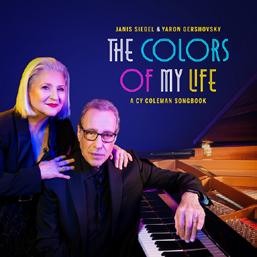
together and developed the idea for the Coleman project. That decision is one that benefits those who enjoy Coleman’s music, especially with the jazzy approach favored by Siegel and Gershovsky. Coleman would surely have dug the results. yaronmusic.com
In 2001, vocalist Jeff Harnar recorded Sammy Cahn All the Way on a label that soon folded. The album was well-received when it was released
but has remained out of print until this year when the folks at PS Classics decided to release it with a few new tracks, some reworking of the original material, and the dropping of some of the original performances. The result is a delightful 16-track album that is as fresh as today. Harner has been among the finest cabaret singers since he arrived on the scene in the mid-1990s. Jeff Harnar Sings Sammy Cahn: The Second Time Around (PS Classics – 2455) is the new release, once again with superb charts by Alex Rybeck, Harnar’s long-time Musical Director. Among the new tracks are duets with Nicole Zuraitis, “Come Fly With Me,’ Clint Holmes, “Come Dance with Me”/”I Like to Lead When I Dance” and MOIPEI, a vocal trio, “Bei Mir Bist Du Schön.” Sammy Cahn would surely have shown enthusiasm for this album. You will share that enthusiasm! psclassics.com
Continued from page 24
“People Didn’t Know What ‘Mas Que Nada’ Meant, and It Didn’t Matter. It Just Made People Feel Good”
Sergio Mendes studied classical piano while growing up in Brazil. When he was about 15, he was given a a recording by Dave Brubeck, and that, he said, “changed my life.” He became a fan of other American jazz musicians and started listening to the music of such artists as Charlie Parker, Bud Powell, and Art Tatum. When he began performing in Brazil, he met Antonio Carlos Jobim, who became his mentor. Mendes, who died September 5, 2024, in Los Angeles at the age of 83, moved to LA in 1964, the year that Astrud Gilberto and Stan Getz’s recording of Jobim’s “The Girl From Ipanema” became a huge hit, popularizing bossa nova in the United
States. Mendes formed a septet, featuring himself on piano, two female vocalists, bass, percussion, drums, and guitar. He called it Brasil ‘66, and Herb Alpert, trumpeter and leader of the Tijuana Brass, co-produced the album, Herb Alpert Presents Sergio Mendes and Brasil ‘66 on Alpert’s A&M label.
The album sold 500,000 copies and later was named to the Grammy Hall of Fame. It featured such songs as Bobby Weinstein and Teddy Randazzo’s “Goin’ Out of My Head” and Jorge Ben’s “Mas Que Nada”, which means ‘No way’. In a 2021 interview with the Los Angeles Times, Mendes said, “People didn’t know what ‘Mas Que Nada’ meant, and it didn’t matter. It just made people feel good.”
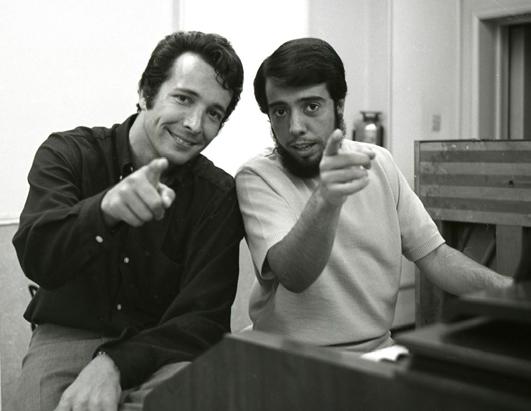
Alpert, who married one of Brasil ‘66’s vocalists, Lani Hall, described Mendes on Facebook as “my brother from another country. He was a true friend and extremely gifted musician who brought Brazilian music in all its iterations to the entire world with elegance and joy.”
Mendes had four consecutive gold albums. He won two more Grammys and was nominated in 2012 for an Academy Award for best original
song, as co-writer of “Real in Rio” in the animated movie, Rio. Other Brasil’66 hits included Brazilian arrangements of the Beatles’ “The Fool on the Hill” and “With a Little Help from My Friends”, Otis Redding’s “(Sittin’ on) the Dock of the Bay”, and Simon and Garfunkel’s “Scarborough Fair”. Mendes is survived by his wife, Gracinha Leporace; their two children; three children from an earlier marriage; and seven grandchildren.
THANK YOU and welcome to all who have recently joined or renewed their memberships. We can’t do what we do without you!
Your membership is vital to NJJS’s mission to promote and preserve America’s great art form— JAZZ!
Paul Flexner
MORRIS PLAINS, NJ
Donn & Pamela Mansfield CHATHAM, NJ
James Ballard
EAST GREENWICH, RI
Wayne Chaneski
EDISON, NJ
Alexis Cole
JAZZ VOICE
Patricia Curry VAUXHALL, NJ
Scott Heavner WAYNE, NJ
James Nissel MALVERN, PA
David Orthmann WANAQUE, NJ
Cliff Roberts
BRIDGEWATER, NJ
Sid Sirulnick HACKENSACK, NJ